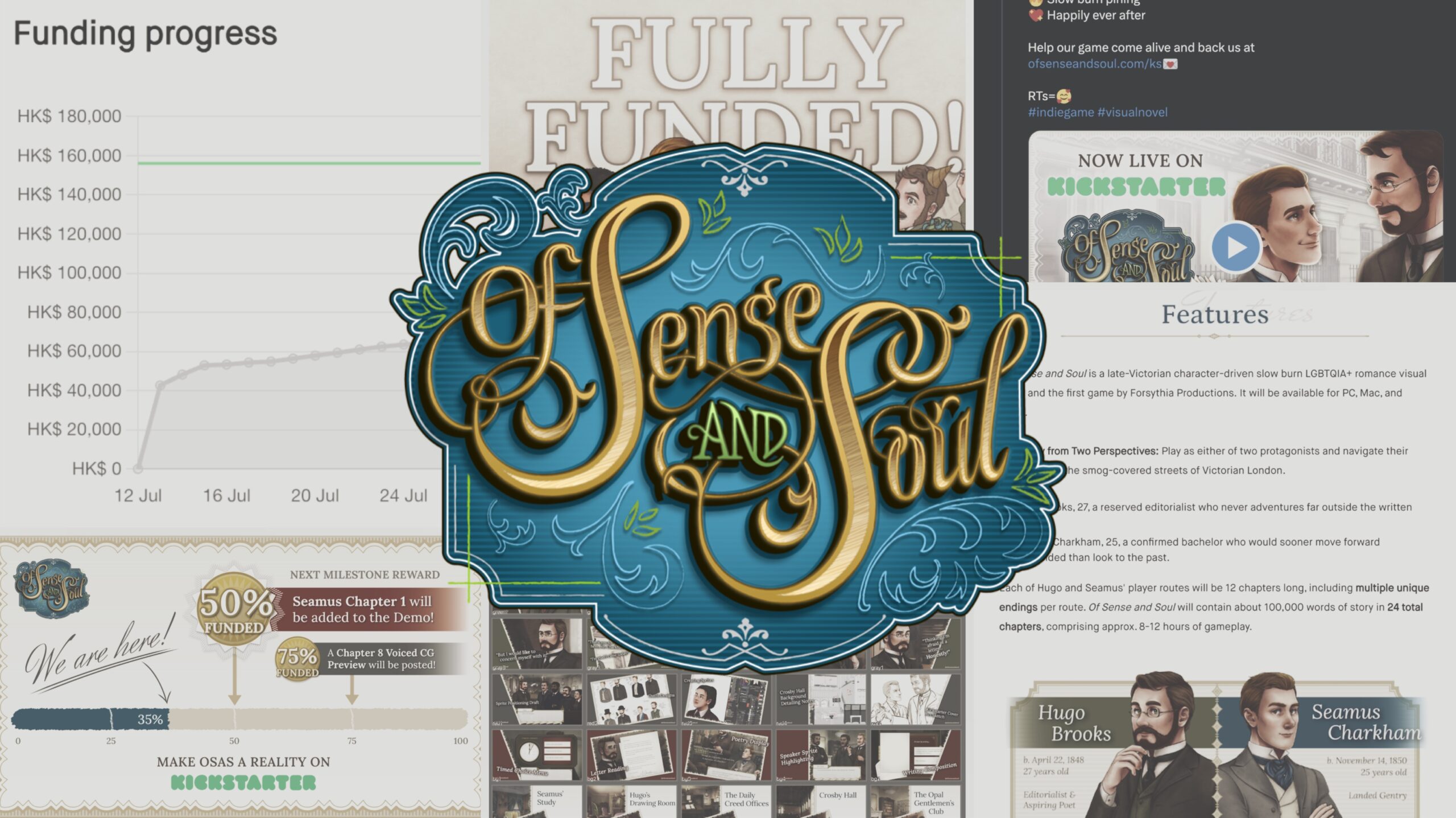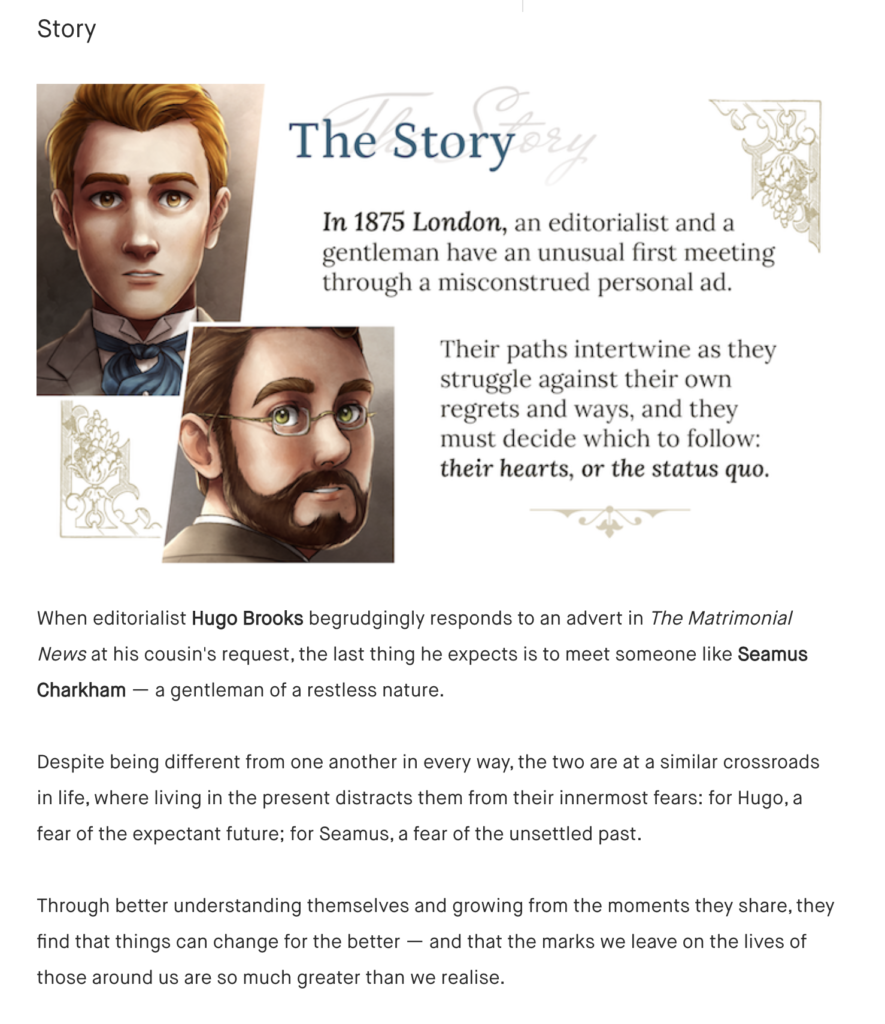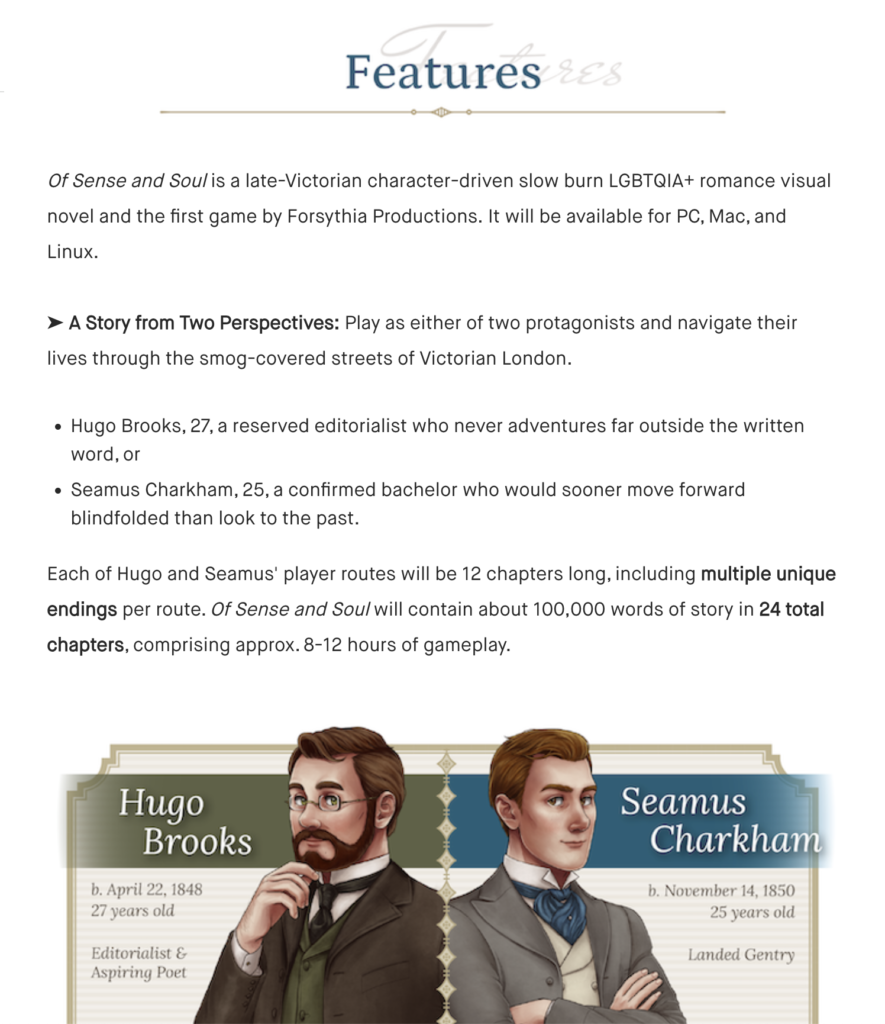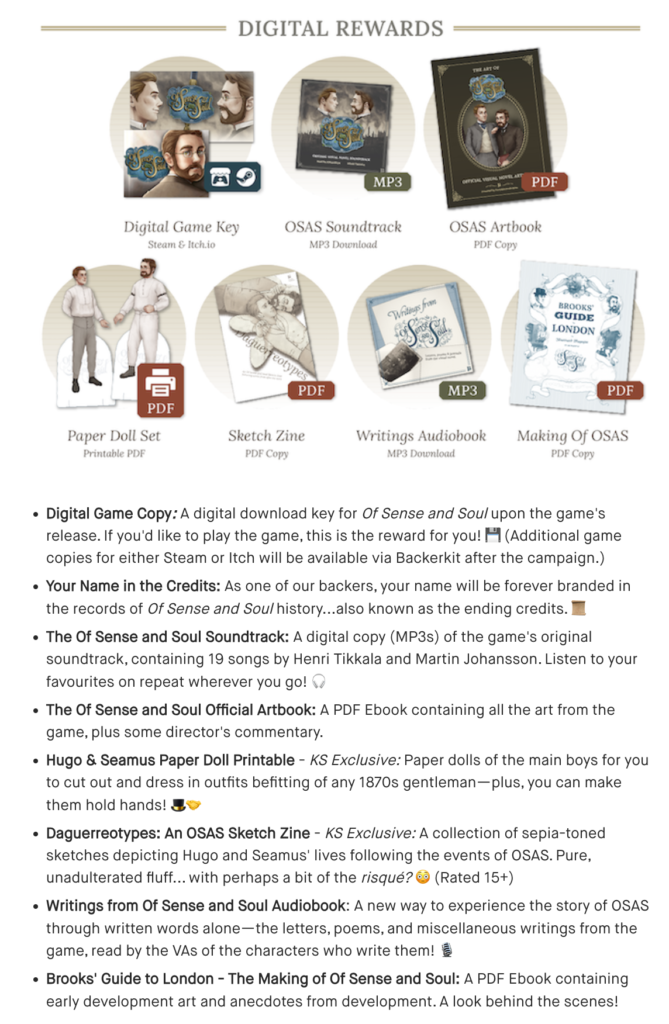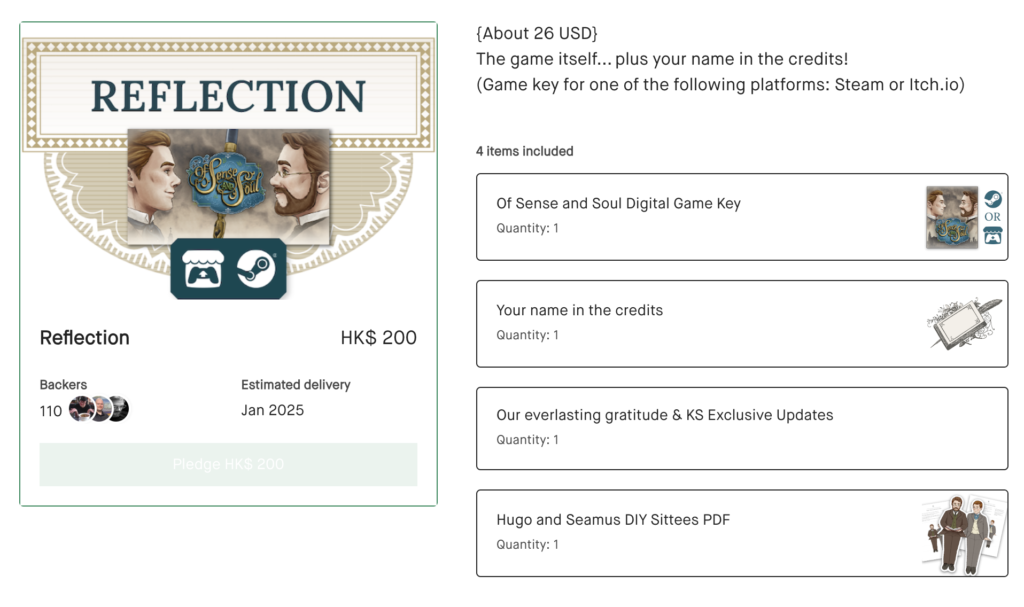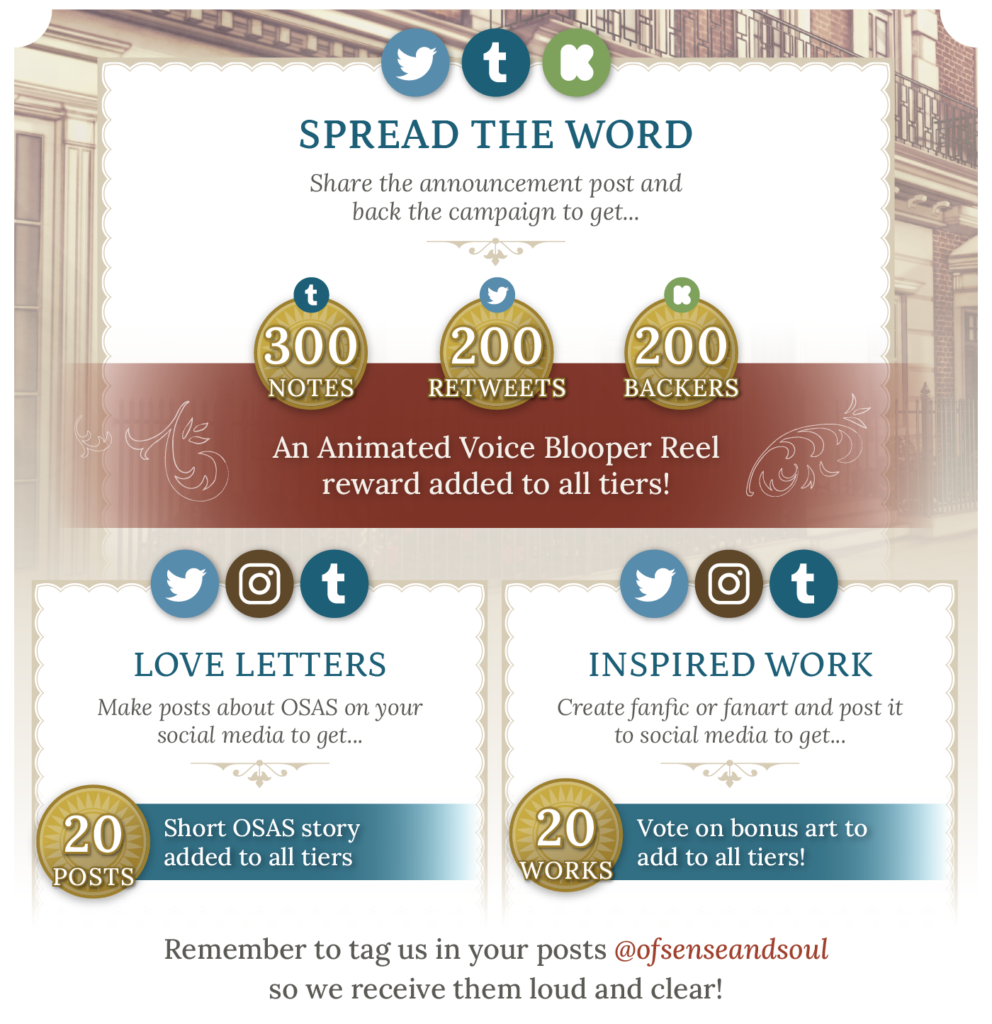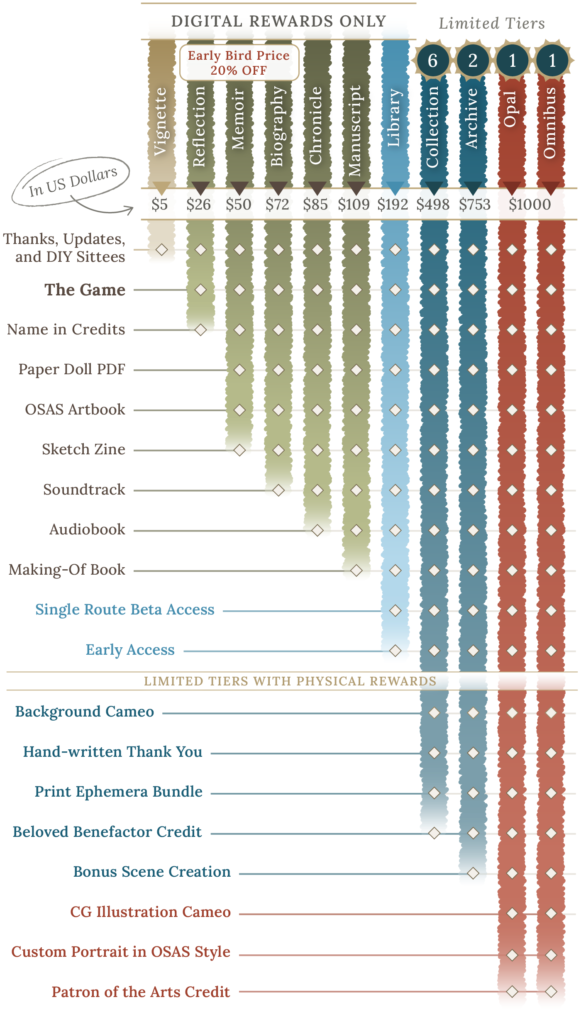It was only in the last 40 minutes of the Of Sense and Soul Kickstarter campaign that we went from assuming failure to being funded fully—it was thanks to a very generous last-minute contribution that we were able to cross the finish line and say for certain the campaign had been successful, and that we could, thankfully, cover the costs of production for the game.
We reached our goal—but certainly, there were many other potential outcomes for the campaign, and many factors that have gone into the result we have achieved.
Rather than explaining it all in metrics—which I find have never been truly indicative of impact when it comes to Of Sense and Soul—I’d like to tell you the story of how we got to where we are now, what decisions were made in the process, and what I took away from the experience beyond the funding itself.
Of course, there will be numbers along the way—albeit to punctuate those topics!
The Lead-Up
Setting Our Sights: 2019-2022
Preparations for our Kickstarter reach far back into the beginnings of the game’s development. Of Sense and Soul (OSAS) has always been an ambitious brainchild, and some form of crowdfunding has been in our sights since we started making the 2020 demo. We knew then that it would require more than just the powers of Rowan and I combined to create it, and if we wanted to do so bearing fair compensation for our future team in mind, it would require some external funding.
As first-time developers, however, continuing onward with development after the 2020 demo was too high of an obstacle. That first year of development proved incredibly difficult, with the first demo not even containing half of the content we had intended to include in it, and burnout clashed with our individual life circumstances to make development unviable for some time.
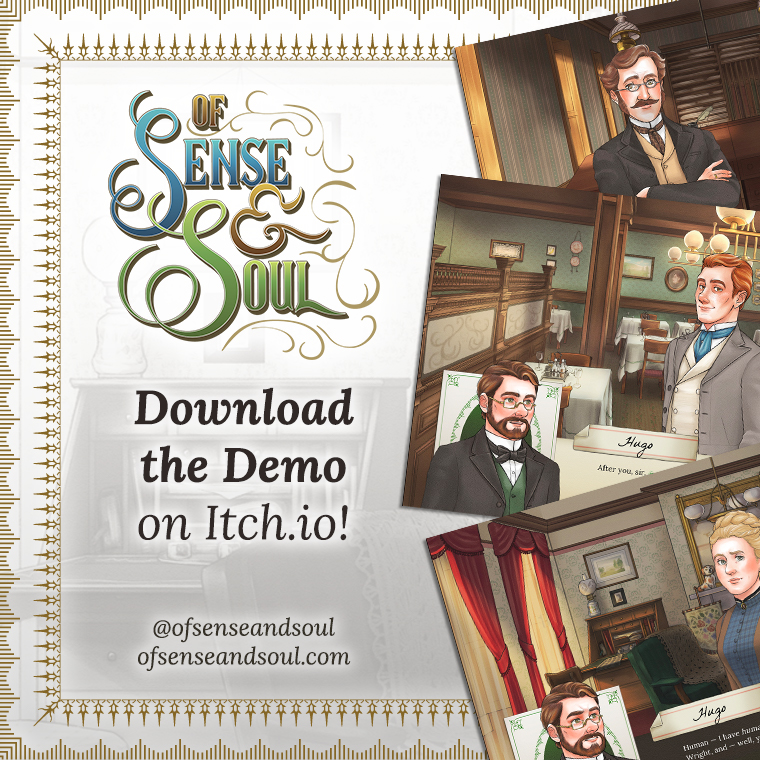
Over those few years, I spent a lot of time in development communities (such as DevTalk on Discord) where more experienced developers and their own visual novel Kickstarters regularly came and went. Studying their campaigns and observing the conversations there proved invaluable to building Of Sense and Soul up again—it was only in 2022 that we were able to rekindle efforts to create the game and do so with the skill and knowledge necessary to realise our vision.
The Extended Demo
Our first step towards the campaign was the creation of the Extended Demo, as the original demo had become obsolete and no longer reflected the skill we would be bringing to the game’s newest iteration. We wound up completely overhauling the game over the course of the year, and were able to release the new demo in January 2023.

The initial response to the Extended Demo was very lukewarm—it even paled in comparison to the reception of the 2020 demo! It was disheartening, but in a new game landscape of many more options compared to the offerings on Itch.io in 2020, it made sense. It was all we could do to continue making and marketing the game to build our audience.
(In fact, as of today on Itch.io the Extended Demo only has 613 downloads, 24 ratings, and 8 comments. Not very much, in the grand scheme of things!)
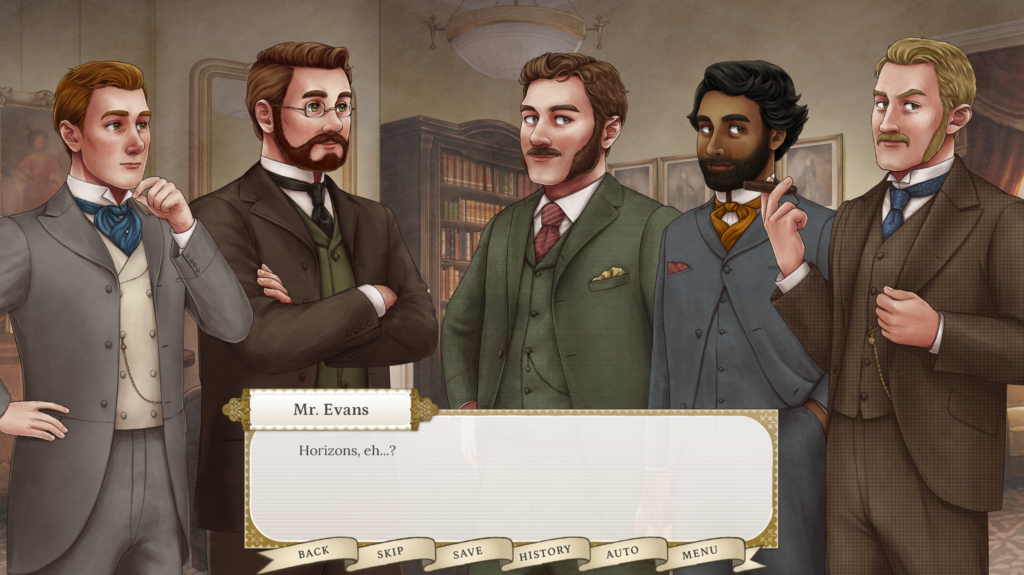
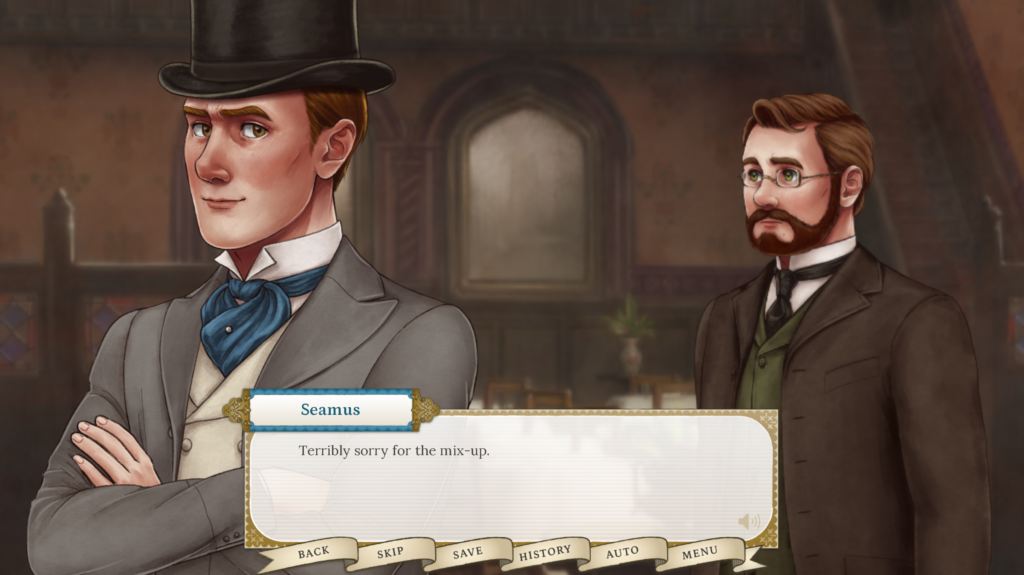
With the release of the demo came a soft announcement we would be having a crowdfunding campaign. No date was determined at this point, but I had earmarked May in my head—I wanted to capitalise on any momentum the voiced update to the demo would generate in March.
The campaign was pushed back to July due to travel plans, and I am very glad, in hindsight, that we had that extra few months, because it gave us valuable time to market the game.
Building Up Hype
Despite the quality of Of Sense and Soul, we have had a lot of difficulty finding our audience.
As proud as we are of OSAS’ uniqueness, this has made it difficult to sell on first sight; it doesn’t look or sound like a lot of other queer romance visual novels (or even queer stories in general). With the few but fervent reviews we had gotten of the demo, we knew it wasn’t a matter of improving our product but one of finding the right audience for it—an audience of people who would, hopefully, become invested enough to support crowdfunding efforts for OSAS.
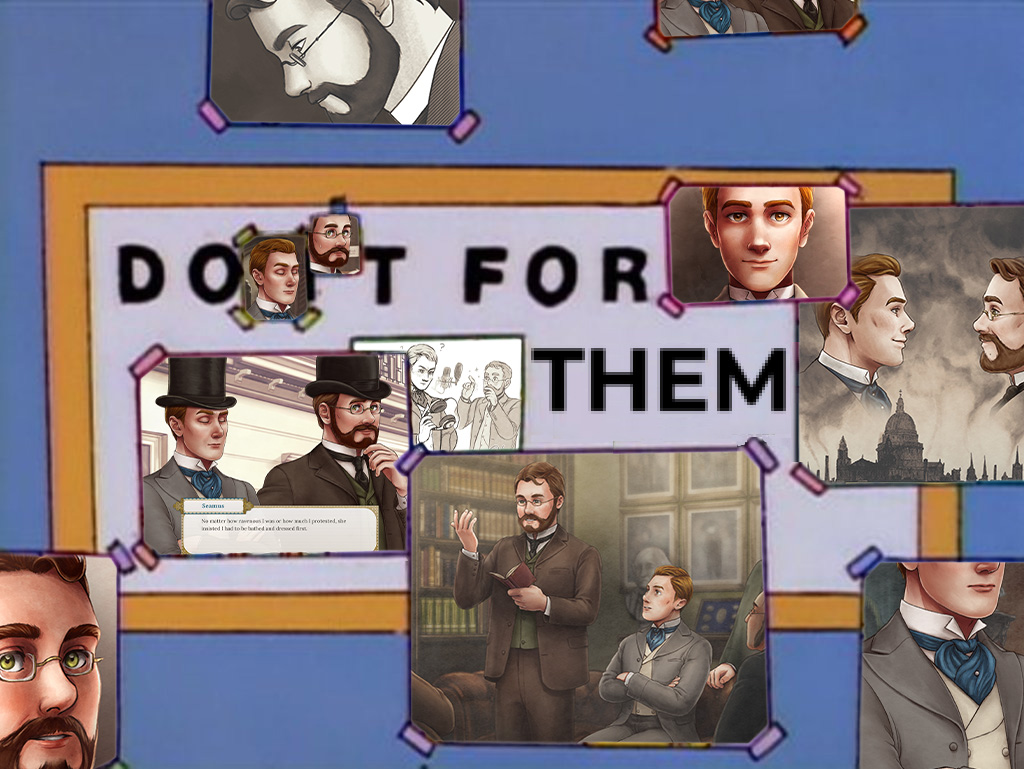
Given the difficulty of gaining traction, something in our marketing approach had to change in order to give us a fighting chance at a Kickstarter. Once the Extended Demo’s Voice Update was released, I largely directed my energy towards promoting the game.
Our Existing Audience
We had built a decent Twitter presence and small Tumblr one by this point, with around 600 Twitter followers and 140 or so on Tumblr—small, but still present. We also had a Discord Server of about 70 members, though there was little to no community management and thus little engagement in it. Our newsletter was at that point also relatively successful, with a 49% opening rate for our audience of roughly 80 active subscribers.
These are very modest figures, yes—but what I did know OSAS had was staying power.
Throughout the years and more recently with the Extended Demo’s release, I’ve had surprise encounters with our supporters—people who have kept tabs on OSAS since the original demo’s release in 2020. The sporadic messages, comments, emails, and the names that I’d recognise time and time again in our post notifications all indicated to me that what audience we do have is certainly there, but that they lean towards reservedness instead of being vocally supportive.
With this in mind, I had to re-approach marketing from a different angle in order to attract new supporters to our “hidden gem” in the lead-up to the campaign.
A Spin-off
As part of selling Of Sense and Soul and getting new eyes on the Extended Demo, we released a short spin-off game titled Confluence: An OSAS Soliloquy for the O2A2 Game Jam Queer Edition which took place in April.
It was designed to make the quality of presentation and intentions of OSAS’ narrative very clear. As an epilogue to Hugo’s route, it exemplifies the emotionality and “end goal” of the main game. As an experience in itself, it boasts the same writing, cinematography, music, and overall production quality as OSAS.
Its much shorter length and in-browser playability means it also has a lower barrier of entry to people who are OSAS-curious! It was quite well received, and gave our studio some additional credibility on top of attracting some new players to the main story.
(This also served as extra content for our promotional streamers, one of whom got through the entire demo and Confluence with time to spare.)
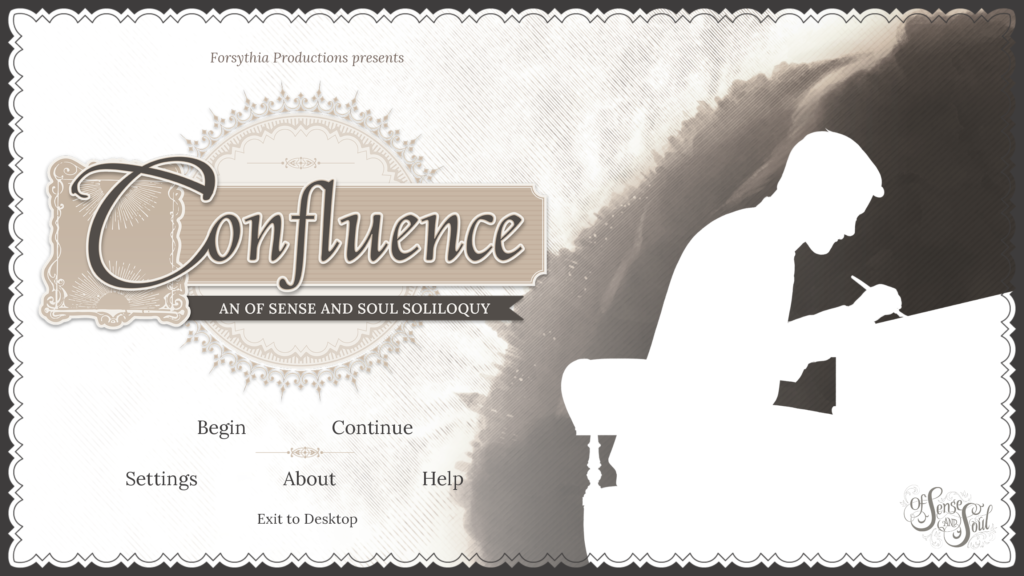
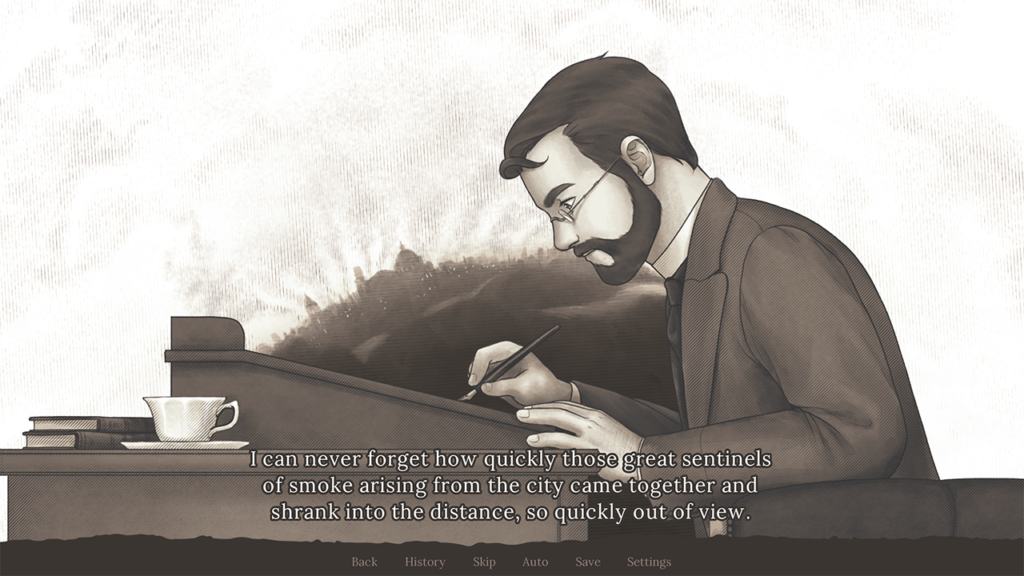
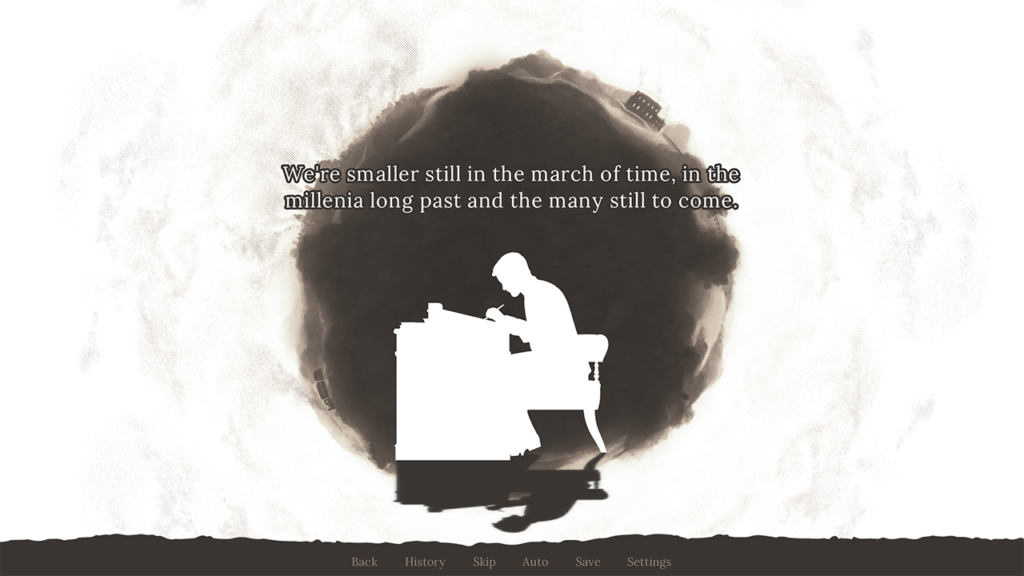
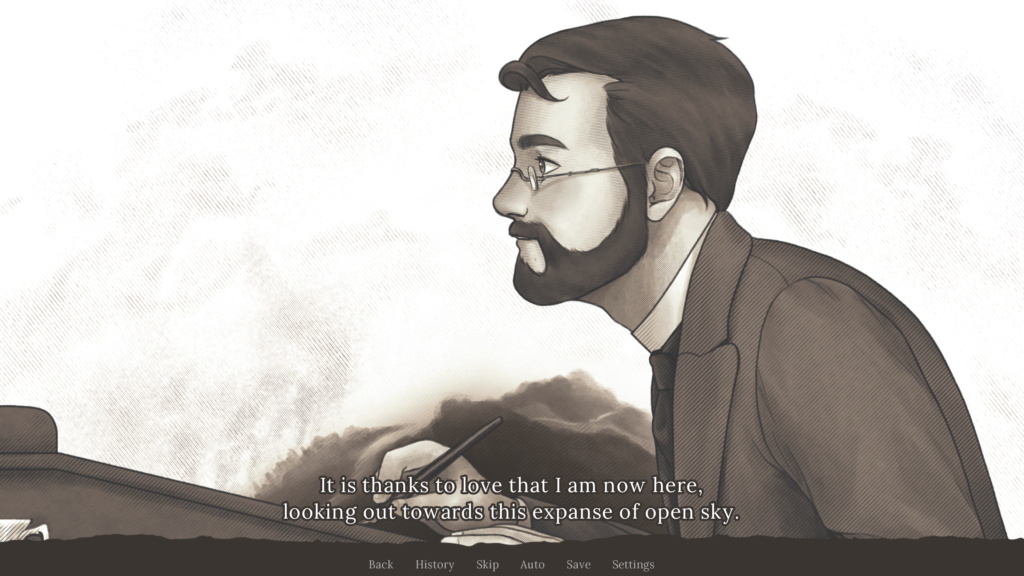
Selling Points
In examining the qualities and effects of the game itself, I landed on the idea of relatability as being a key selling point. As OSAS is a character-centric narrative, players are immersed in the roles they play as Hugo and Seamus and our Demo Feedback Form results confirmed this.
Many players pinpointed core characteristics and challenges of each protagonist when asked which they found more likeable or relatable:

Feedback form respondents who found Hugo most relatable found his introspective, socially awkward character, his love of reading, and his slow growth out of his shell most notable.
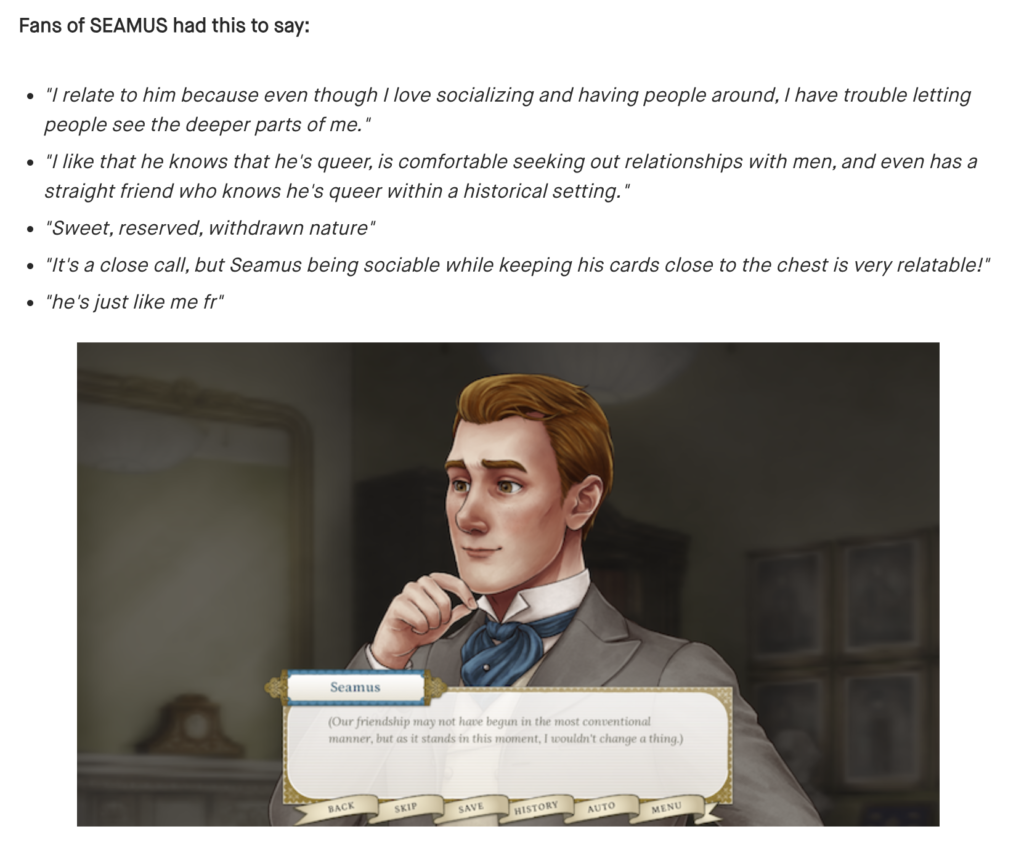
Feedback form respondents who found Seamus most relatable noted his withdrawn, reserved, sweet nature. (And, of course, his obvious queerness!)
We had been selling the game on its polish and general storyline up till that point, and I decided to shift our messaging towards the characters’ traits and experiences which resonated with our players.
Our primary social media platform, Twitter, had begun its descent into madness earlier in the year, so I decided to shift more attention to Tumblr for our marketing. I was already familiar with the platform’s fandom-influenced culture and its love of queer narratives, and knew there would be an audience for OSAS there.
I would no longer be selling “the game”; I would be selling the characters, their slow burn romance, and all the emotions that accompany them. I began to draft posts that had a tongue-in-cheek self-awareness to them, riffing off of existing meme formats and the relatable moments in the story.

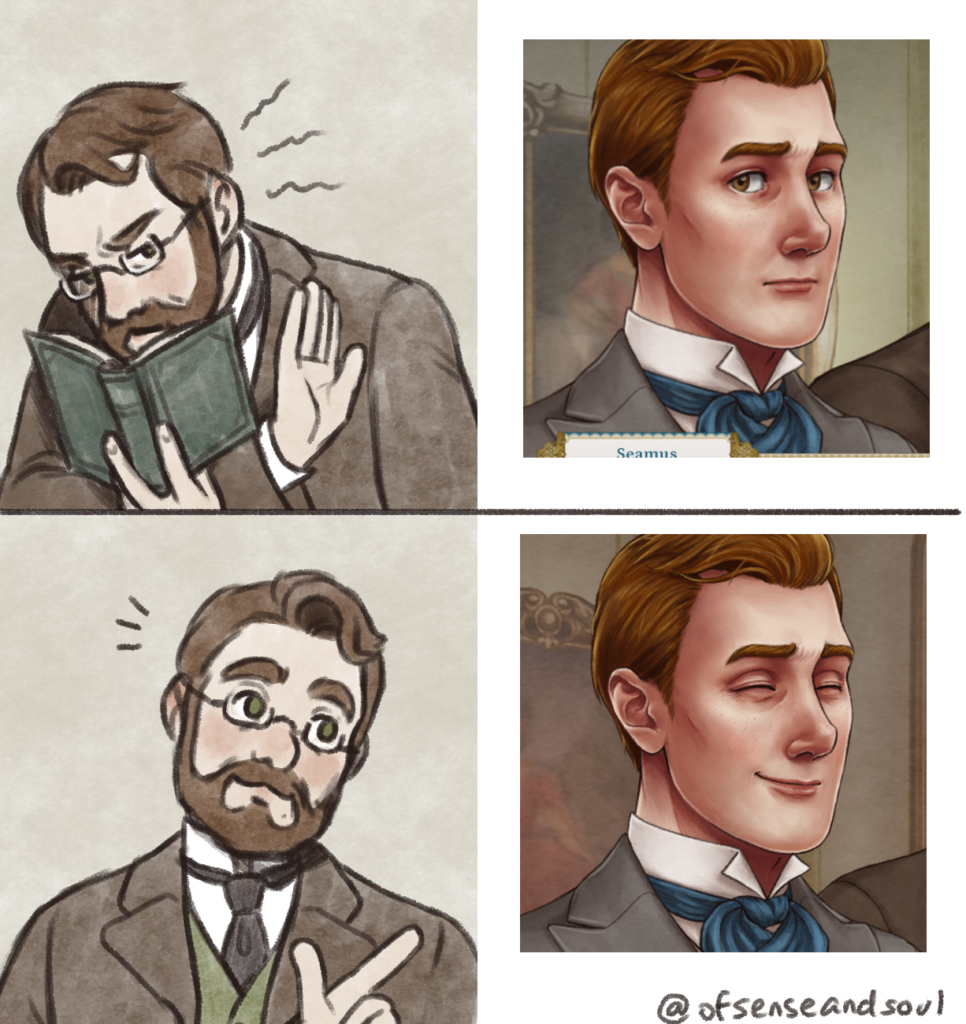
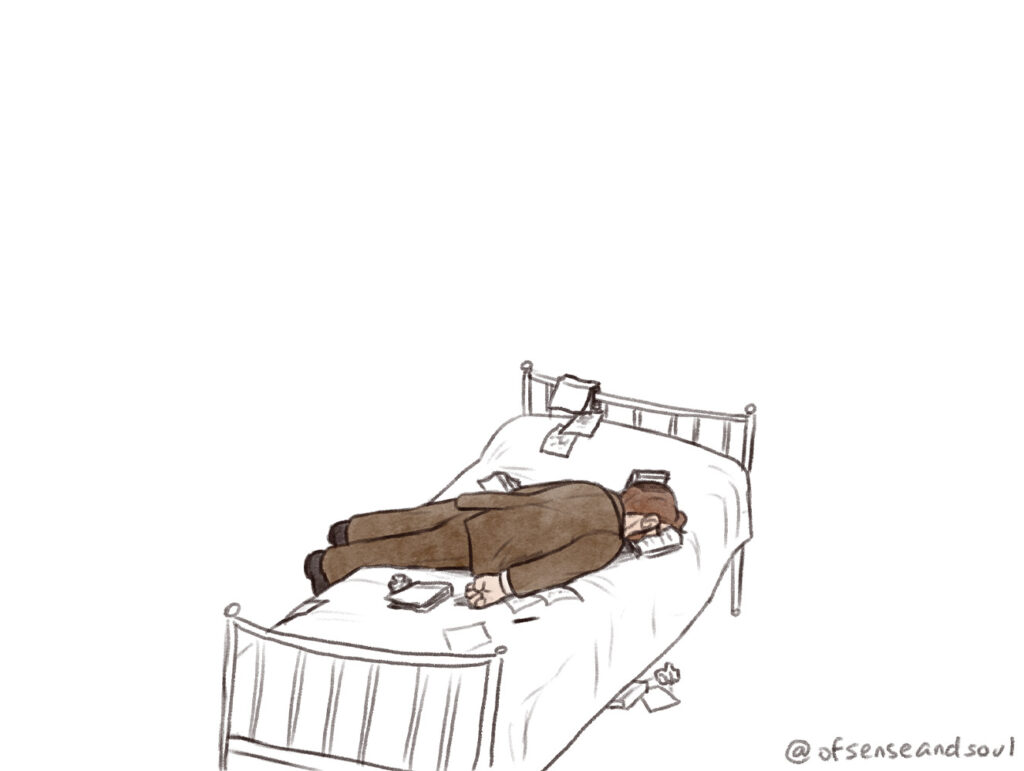
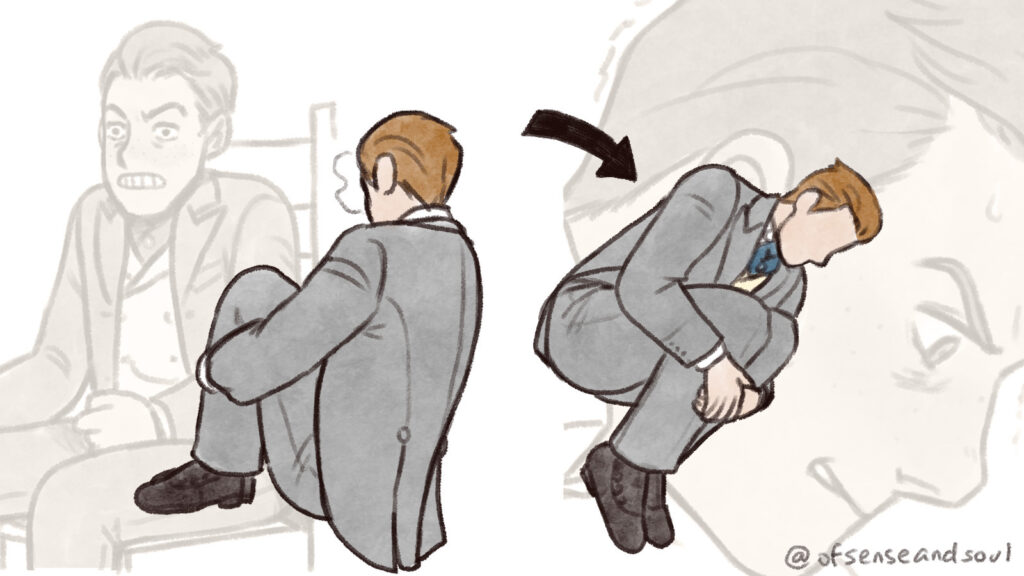

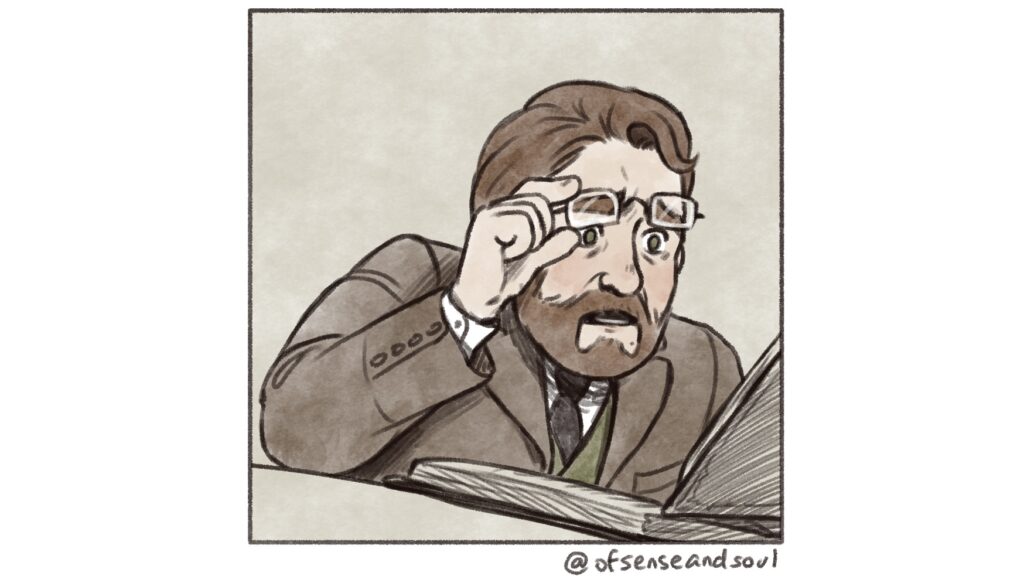
Listening In
My search for “relatability” was in part aided by the live directed voice acting sessions for the game. As I listened to the full session recordings, having been unable to attend myself, I was able to hear the live reactions our voice director (MAHO!Cody) and lead actors (Max Herzfeld and Shaun Mendum) had to the story and its character moments.
We’re fortunate to have found leads who connect with the story itself and relate deeply to the roles they play; the trio’s takeaways from each scene very much informed my understanding of the narrative’s impact. There was a sense of humour and connection I found there that I could only really understand from an outsider perspective when hearing it be discussed by others.
Being a fly on the wall for those recordings was a real help when I was refining the voice I wanted for marketing OSAS on Tumblr—it was a key to getting a little un-serious about the game in an attempt to be very serious about selling its merits.
Blaze It: Paid Promotion
With its low barrier to entry and promising potential audience reach, Tumblr Blaze was one place I felt comfortable trying paid promotion—and heeding the advice of other devs as well as my own experiences on the platform, I tried several approaches to our Blazed posts. True to the advice I was given, posts with more colloquial, humorous, or light-hearted content were more successful and posts with clear promotional content struggled to receive engagement.
All in all, I blazed 10 posts from May onwards, leading up to the start of the campaign itself. At US$25 per 7,000 impression blaze, it was altogether no small investment, but I credit this approach with having given me a clearer idea of who I should be “talking” to in marketing the game, as well as the demographics of the Tumblr users who are at least a little interested in OSAS. I won’t delve into an analysis of every post I blazed, but the first two were indicative enough of the overall landscape:
Our first Blazed post in May was a very straightforward sell of the game and the Kickstarter Pre-Launch. Our second was a simply illustrated parody of the Drake meme featuring Hugo and a simple game premise.
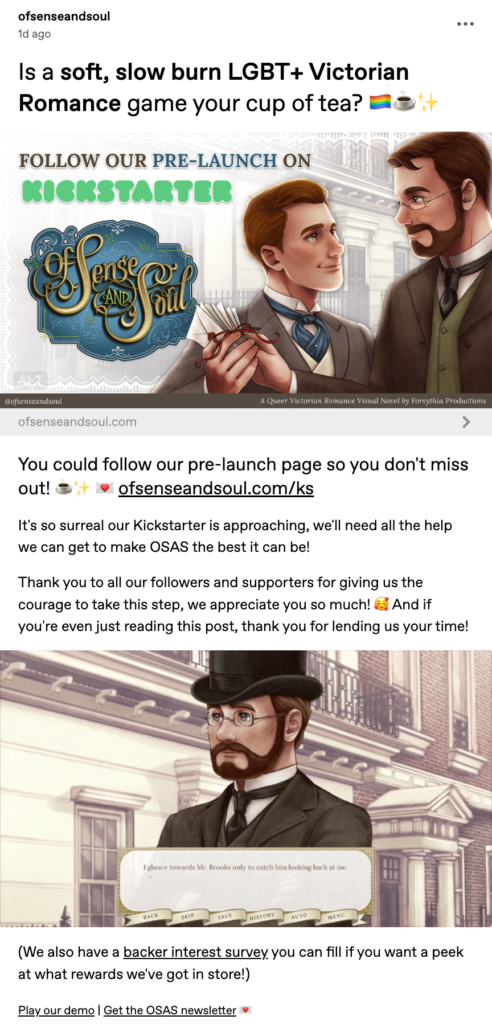
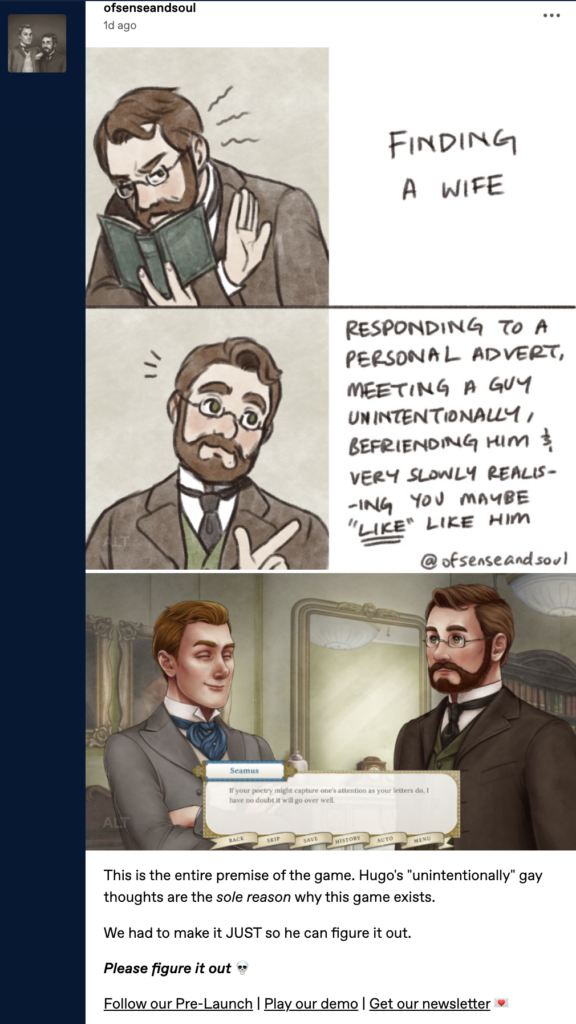
Despite being only days apart and being blazed at around the same time for the same minimum of 7,000 impressions, the second received over double the engagements of the first.
| Blazed Post | Impressions | Likes | Reblogs | Clicks | Follows* | Total |
|---|---|---|---|---|---|---|
| Pre-Launch Promo May 18, 2023 | 10.2K | 71 | 18 | 19 | 3 (1) | 111 |
| Hugo Drake Meme May 23, 2023 | 10.7K | 186 | 23 | 26 | 14 (2) | 243 |
| Difference | 0.5K | 115 | 5 | 7 | 11 | 132 |
*I found that the “Follows” measurement on the posts themselves were only indicative of people who clicked on “Follow” from the post, not of the actual follower growth during each blaze. Here I’ve counted all follows made to our account from the 24h Blaze period, as our account is small enough that no activity was coming from other posts on our blog. The number in parentheses was counted by the Blaze Report.
With the results from these two Blaze posts, I knew I was on the right track in resonating with our audience.
Subsequent posts and Blazed posts were a mix of promoting the game and its characters through relatable content and of delivering information about OSAS’ development and features through game art and showing works in progress.
Press, Creator, and Streamer Outreach
Up till this point, I had only sent infrequent emails to press outlets and streamers regarding the Extended Demo—after all, it was work enough to actually make the game, especially with as many roles I take on—but it became especially important to do independent outreach as we geared up for the Kickstarter. Over the course of May and June, I researched potential outlets for coverage of OSAS (on top of a pre-existing list I had compiled) and sent countless emails to press outlets and streamers alike.
Press outreach has been a struggle for OSAS—whether due to the email content or the niche appeal of the game itself, we’ve received little press coverage, save this article from Gayming Magazine and this post from Wraithkal.
OSAS is visually set apart from many visual novels because of its semi-realistic art style, meaning it isn’t a good fit for outlets which focus on Japanese visual novels or visual novels styled like them. It’s a visual novel, making it difficult to sell to indie game press outlets which primarily focus on non-narrative games with stronger gameplay focus.
We also received a few playthroughs on YouTube, namely from Blancokix (who also played our 2022 prototype), Visual Novelty, and later from Gaymer Gecko during the campaign.
Twitch Streams
With these results, I instead turned my focus to streamers instead. I posted OSAS to the Rubber Ducks Discord Server, a community with the aim of connecting streamers to indie developers, and found our first Twitch streamer through it.
icanbeyourqueero streamed the full OSAS Demo on June 7th, and I was thankfully in the right time zone to watch the stream. Through it and the playthroughs we’ve received, I saw how well Of Sense and Soul could perform in front of an audience.

With its heavily cinematic style and wealth of evocative moments and comedic flair, the game has proved impressive as a streamed experience. I’m pleased to say that quite a few streamers (including some we didn’t reach out to) have picked the demo up, including Otomeaddicted, kat_ri_elle, ashiirose, and n4c9sart.
(n4c9sart, in fact, has also been a very vocal supporter of our game and posted some amazing fan art for the game during the campaign! I’d highly recommend checking them out on their carrd.)
Knowing the game’s strengths as a streamed experience, I also approached two streamers for promotional streams, which I will elaborate on in my reflection of the 30 days of the campaign itself.
Crafting the Campaign
As a quick aside, at the start of planning the Kickstarter this year I wasn’t even sure if there would be a campaign at all—in December 2022, the Hong Kong government initiated a three month public consultation for new legislation on crowdfunding activities, and the proposal included legislation that could potentially risk Kickstarter and other platforms like it leaving the region altogether.
For several months, I waited with bated breath for any sign of these new regulations crawling out of the woodwork, and ultimately decided to move forward with planning the campaign when it became clear it would take some time for legislation to move forward—if at all. Still, I briefed all relevant team members on what could happen if it did and formulated plans for alternative funding.
As of the writing of this post-mortem in August there have been no new developments on this matter since March, so I think we’re in the clear!
Digital Only Rewards
For our rewards, I knew it would be overwhelming (and a massive headache) to even consider physical merchandise and shipping, especially being based in Hong Kong. The challenge then was to make digital rewards that would be attractive and valuable enough to warrant higher tier prices.
In order to minimise the degree to which reward fulfilment would detract from production of the game itself, most of the rewards were also planned to contain content from the game or content which would result from the game’s creation.
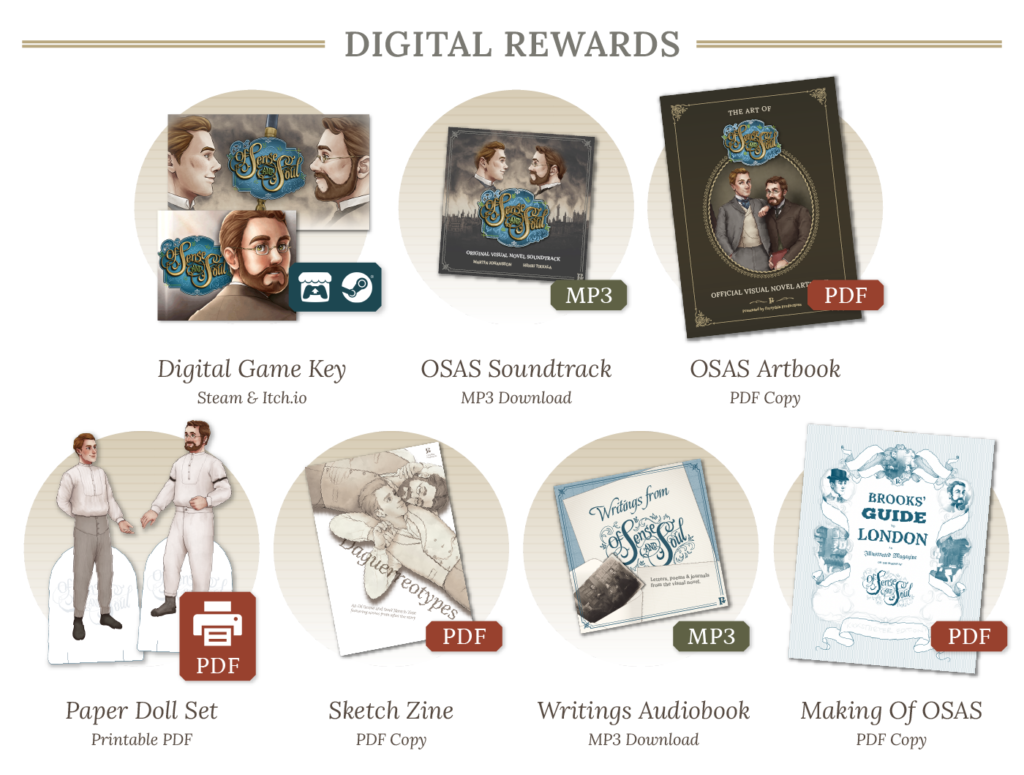
Alongside the “expected” digital rewards such as the art book, soundtrack, making-of book and game keys, I sought to create some unexpected ones.
The DIY Sittee and Paper Doll printable PDFs were one way I tried to set the rewards apart—though we couldn’t promise physical merchandise, we could do the next best thing and offer the option for backers to create their own!
(I elaborated on the planning and creation of the printable rewards in this Kickstarter update.)
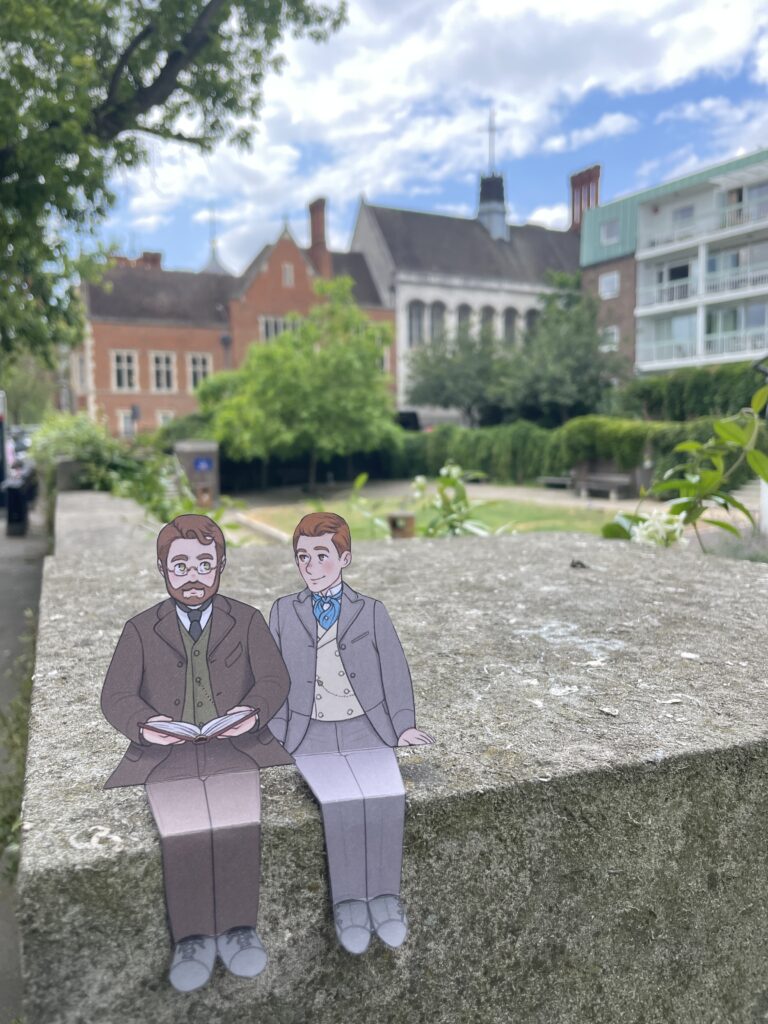
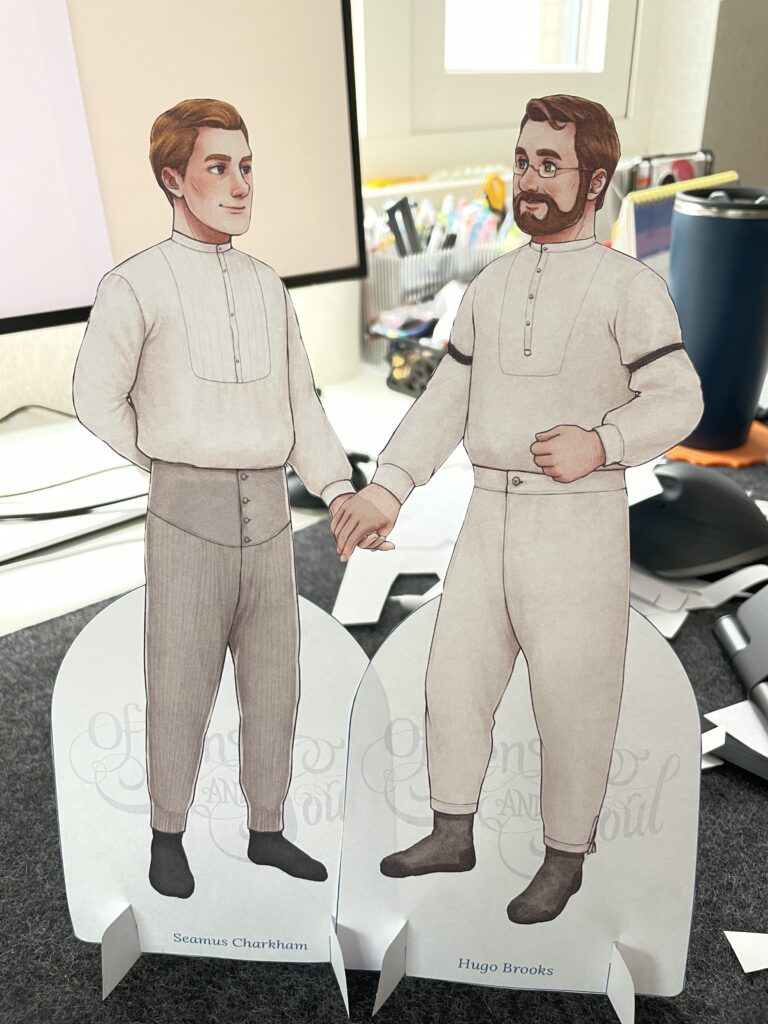
The rewards were all digital with the exception of two—at the very highest Collection, Archive, Opal, and Omnibus tiers, a limited number of Print Ephemera Bundles and Thank You letters were made available. These were planned to ship as flat as possible (being paper goods) in order to minimise shipping and production costs. These high tiers were also paired with customisable rewards such as bonus scene creation and custom portraits or cameos in order to boost their value.
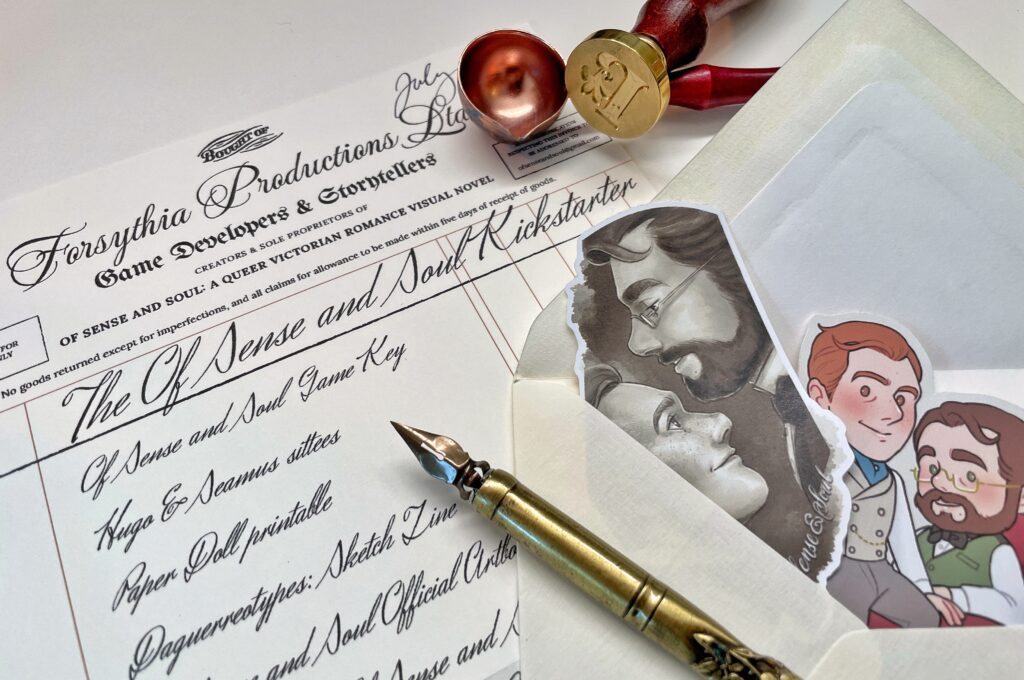
Pricing
Prior to the campaign and even planning its rewards, I had already drafted a budget with estimated costs for the production of the full game. Defining the outstanding assets, story elements, word counts, and other elements up front was how I was able to arrive at our funding goal.
Having researched and compared the pricings on other English visual novels and campaigns of our calibre, I knew that the average game tier price was around US$20 and the Kickstarter average backer amount was US$25.
Our game tier, at HK$200, landed around US$26 depending on the conversion rate.
This was a choice I made based on the relatively high Kickstarter goal of ~US$20,000 as well as the final expected game price of US$28. We also had international transaction and Kickstarter/Payment processing fees to consider, which were factored into the base goal and accounted for about 18% of the funds we were seeking.
Seeing as our campaign currency was in Hong Kong Dollars (HKD), the tiers were converted to USD in the process of deciding them so that I could more directly compare them to other campaigns’ tiers.
We also offered an Early Bird discount of 20% off for the first 24 hours of the campaign, rather than a limited quantity of that tier.
The Kickstarter Interest Survey
Following the lead of the recent Imperial Grace campaign, I had released a survey on April 26th to gauge supporter interest in the rewards I had planned.

In that survey, I included a list of rewards for respondents to choose their five most anticipated from, excluding the game itself. These were the results:
Most Anticipated KS Rewards
- Artbook (85.2%)
- Making-Of Book (59.3%)
- Create a Bonus Scene (59.3%)
- Sketch Zine (55.6%)
- Early Access (51.9%)
- Soundtrack (51.9%)
- Name in Credits (37%)
- Closed Beta Access (33.3%)
- Audiobook of Letters In-Game (25.9%)
- Wallpapers for Devices (18.5%)
- DIY MC Standees/Sittees (14.8%)
- MC Paper Doll Set (11.1%)
The most anticipated proved to be the Artbook, Making-Of Book, and Bonus Scene creation. The least chosen were the printable Sittees and Paper Dolls—however, I attributed that to their being uncommon rewards for VN Kickstarters, and was fairly confident they would set us apart in terms of alignment with our game’s selling points and campaign tone.
You will notice that I had included a device wallpaper in this list. Though better anticipated than the printables, I didn’t include a wallpaper in our rewards because I wouldn’t be able to produce a wallpaper worth selling in the time left. There was also already a wallpaper available to our newsletter subscribers upon signing up.
These results influenced the order in which I put the rewards per tier in our Kickstarter:
- The Paper Doll Set and Sketch Zine were bundled together with the Artbook in order to boost the value of the Memoir tier after the Reflection game-only tier.
- The more popular Making-Of Book was moved up to the Manuscript tier in order to encourage backing at higher tiers.
- Beta Access was packaged together with Early Access for the Library tier.
- The Sittees, though originally planned to come with the game tier, became the Vignette tier reward in order to encourage backing at the lowest tier. Every bit would help, after all!
Campaign Tiers
In the end, these were the tiers I decided on:
| Tier | HKD | USD | Added Rewards | No. of Backers |
|---|---|---|---|---|
| N/A | <50 | <6 | 13 | |
| Vignette | $50 | ~$6 | + Sittees | 11 |
| Reflection Early Reflection | $200 $160 | ~$25 ~$20 | + Game + Name in Credits | 110 74 |
| Memoir Early Memoir | $390 $312 | ~$50 ~$40 | + Artbook + Sketch Zine + Paper Dolls | 29 12 |
| Biography Early Biography | $565 $452 | ~$72 ~$58 | + Soundtrack | 8 7 |
| Chronicle | $665 | ~$85 | + Audiobook | 4 |
| Manuscript | $850 | ~$110 | + Making-of Book | 12 |
| Library | $1,500 | ~$190 | + Single Route Beta Access + Early Access (2 Weeks) | 7 |
| Collection (6 offered) | $3,900 | ~$500 | + Background Art Cameo + Thank You Letter + Print Ephemera Bundle + Beloved Benefactor Credit | 2/6 |
| Archive (2 offered) | $5,900 | ~$755 | + Bonus Scene Creation | 0/2 |
| Opal/Omnibus (1 of each offered) | $7,830 | ~$1,000 | + CG Cameo + Custom Portrait + Patron of the Arts Credit | 2/2 |
| Total Backers | 291 |
The Page
One area I knew I’d have down pat is the campaign page design—having creating consistent brand visuals and marketing materials for the duration of OSAS’s development, I was mainly concerned with the content and user experience rather than making it all look good, since I knew I would!
The cover art was created specifically for use in the campaign—an unfortunate side effect of having a very slow burn narrative is not having much romantic CG artwork in the game itself, and so I drew this cover art with the intent of making it look romantic: prospective backers should look at the campaign and think, “oh, this is gay!” (And not so overtly romantic, however, that it miscommunicates the game’s contents.)
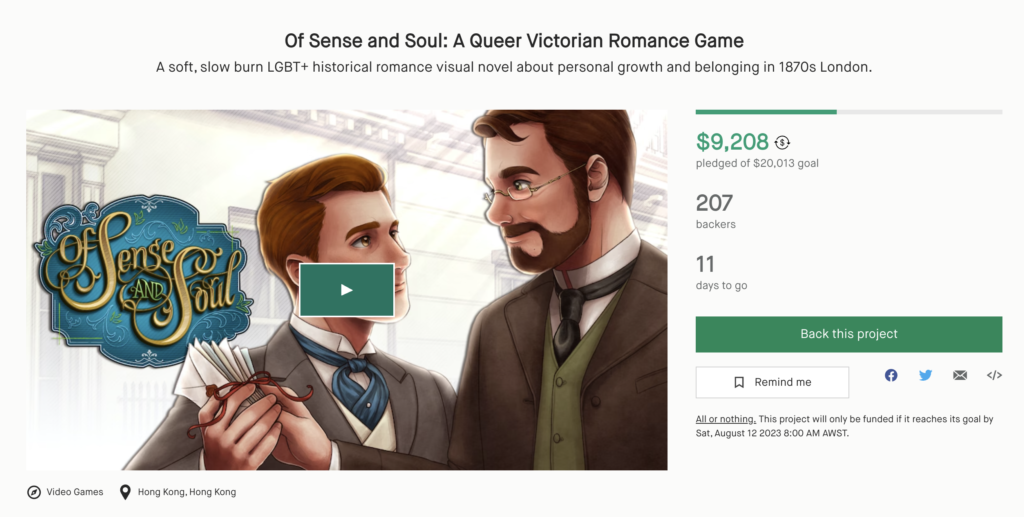
I had been slowly researching and observing other campaigns throughout the years, and so I was able to sequence together visuals and content for the OSAS campaign fairly easily from what I knew I liked from others’. The branding from the game itself carried over into the campaign, so it was relatively simple to style the page.
I started creating the campaign graphics in April (yes, that early!) and did so based on the backer’s journey through a Kickstarter page from top to bottom, from the story to the risks and challenges.
The Backer’s Journey
From my own experience, I knew it could be difficult to take in information on mobile versus on a desktop screen if most of the information is delivered via images only, as these are scaled down on smaller screens.
I opted for fewer text heavy images and put all the information in writing. This was not only to make it easier on viewers’ eyes, but also to make it accessible for text-to-speech use; all the images on the page also featured detailed alternative text for the same reason.
With the addition of reward images and tier images to Kickstarter’s campaign options, I was also able to relegate much of the tier information to the Rewards page, rather than put every tier in the campaign description.
Here are some screenshots from the page:
Marketing Efforts
For marketing efforts on the campaign itself, I knew consistency would be important. In the weeks leading up to the campaign, I prepared a template for a large batch of posts to use before and during it, using existing game assets and Demo content to bulk out the content.
I kept a spreadsheet of post contents including alternative text for all the images, and was able to schedule many posts for Twitter at once. The main focus was on the two weeks before the campaign as well as the duration of it, for which I scheduled one post every day at 8AM UTC+8.
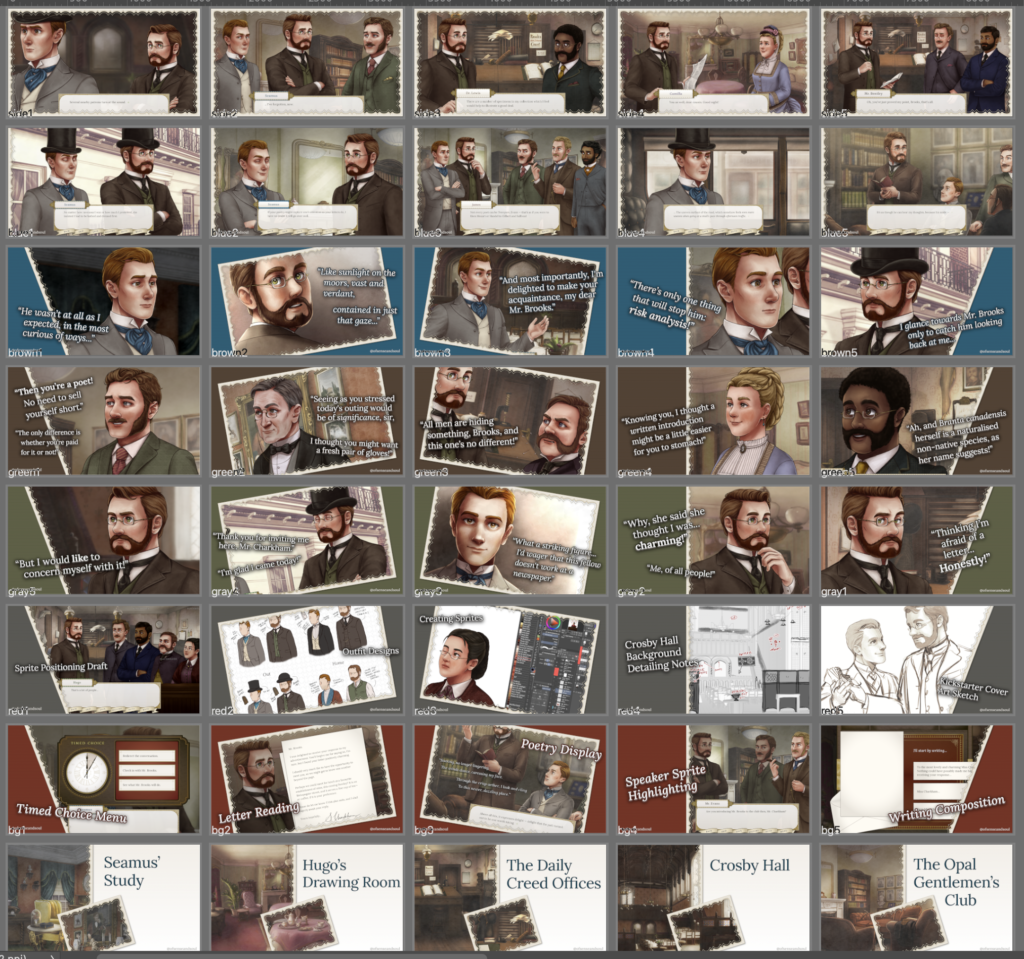
On Tumblr, it was fairly touch-and-go, with posts being cross-posted from Twitter for the most part.
Newsletters were planned to be once weekly except for special updates, such as if the game was fully funded midway through the campaign. They also kept their general structure of including a letter from Hugo on top of our campaign and development updates.
I was careful to keep the tone of the planned/pre-scheduled social media posts on the neutral end as far as the campaign goes; I couldn’t foresee the outcome, so I stuck to showcasing game features, the characters, the story, and generic countdowns. The variety of posts I planned ranged from gameplay screenshots to memes to videos and previews of rewards, such as the Sketch Zine’s contents.
Posting Approach
The approach I use for posting for OSAS in general is also the one I used in marketing the Kickstarter.
The voice I adopt in writing copy for OSAS posts in general is, I would say, “quaint”. I tend to keep an unassuming, wide-eyed, and earnest tone in line with the wholeheartedness and sincerity of the story, and am very deliberate in not trying to “sell” too hard; the game can speak for itself. With the audience we’re trying to reach, I think blatant advertising would work against the product and contradict its aims. As a result, I use an improv-like “Yes and…” structure to any post requiring a more business-like call to action to gently draw attention to relevant links.
I also include consistent emojis across our posts: announcements come with a postal horn (📯) emoji and I use the love letter (💌) emoji alongside links in every post. These have helped cement recognition of our posts in a sea of others’ posts on followers’ dashboards and timelines.
Forethought
Prior to the campaign, I also had a think on what I should be most concerned about as far as the campaign and game went.
I wasn’t concerned about the quality of the communications or of the game and graphics. The pre-scheduling of all our posts and semi-drafted newsletters meant that I was no longer concerned about consistency.
It was getting visibility and rallying our following which I felt would be the most difficult aspect of the campaign, given the existing audience factors I discussed above.
We had a relatively high goal for the size of that following, so I came up with some additional incentives.
Community Challenges
Like many other VN campaigns, I added the following community challenges in order to encourage more vocal support for the campaign.
The offer of additional content outside of the game itself was what I leaned on for this, with exception of the added Seamus chapter for the demo at 50% funded.
- Spread the Word: Share the announcement post and back the campaign to get an animated voice blooper reel reward added to all tiers.
- 300 Tumblr Notes, 200 Retweets, 200 Backers
- Love Letters: Make posts about OSAS on your social media to get a short OSAS story added to all tiers.
- 20 Posts across Twitter, IG, and Tumblr
- Inspired Work: Create fanfic or fanart and post it on social media to get bonus art, to be voted on by backers.
- 20 Posts across Twitter, IG, and Tumblr
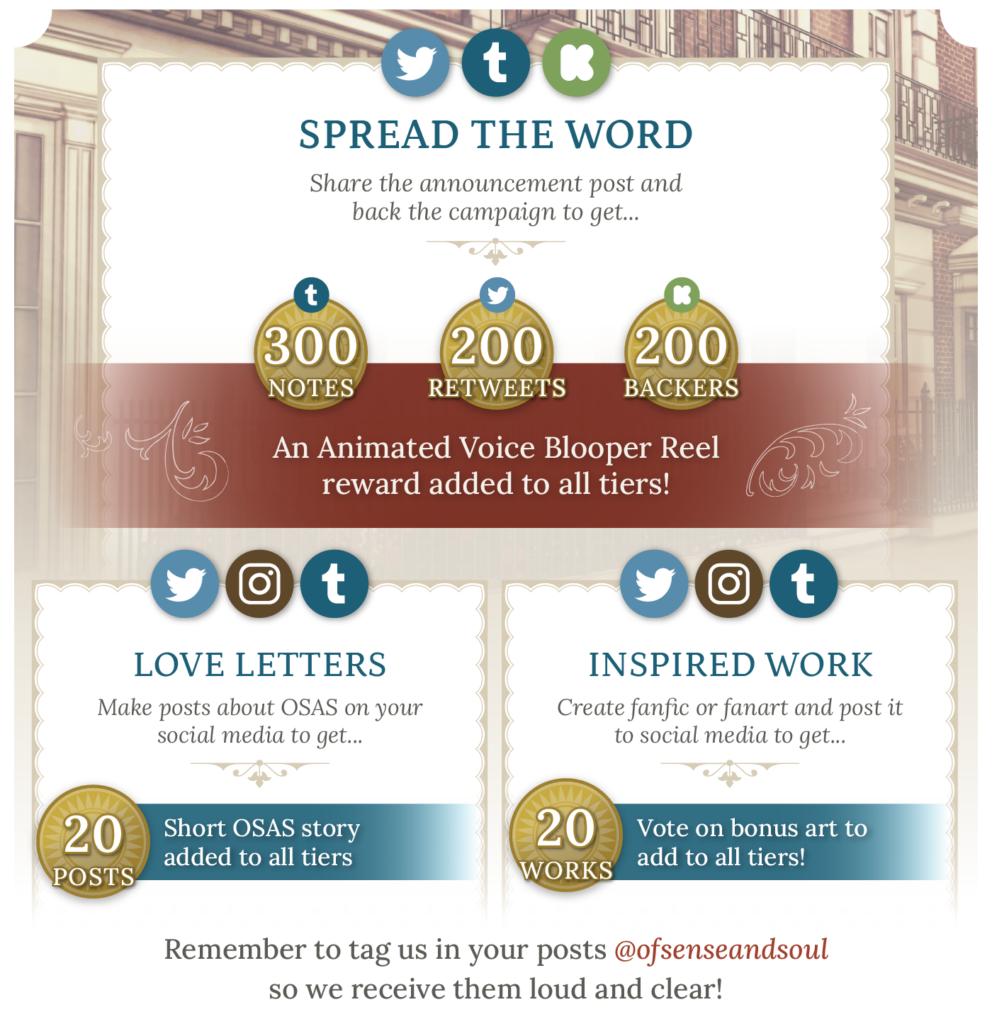
After the first few days, I introduced Milestone Rewards to encourage backers to help us steadily towards the halfway and three-quarters funded marks.
These included added Demo content at 50% funded and a voiced CG preview at 75% funded.
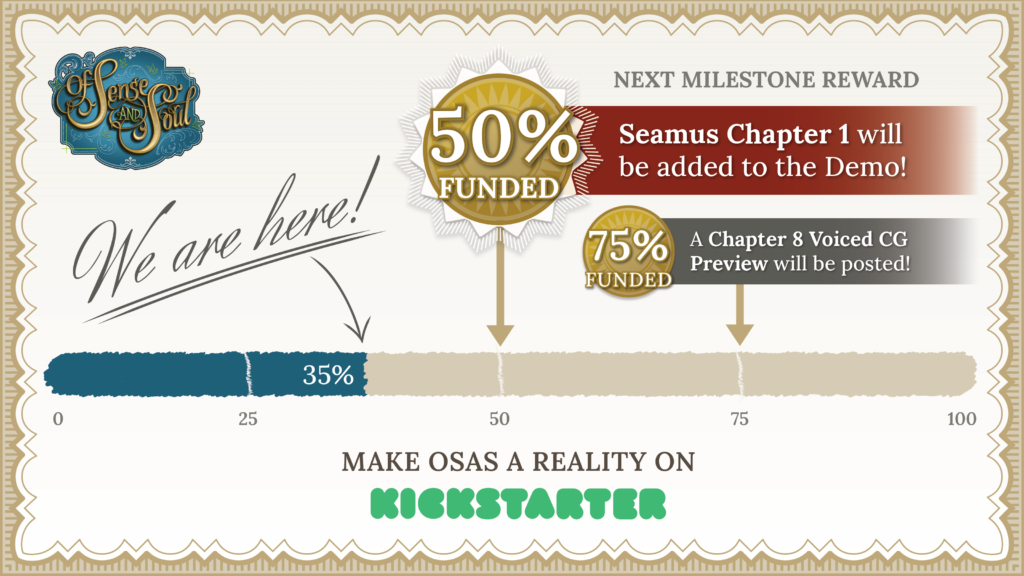
All or Nothing in 30 Days
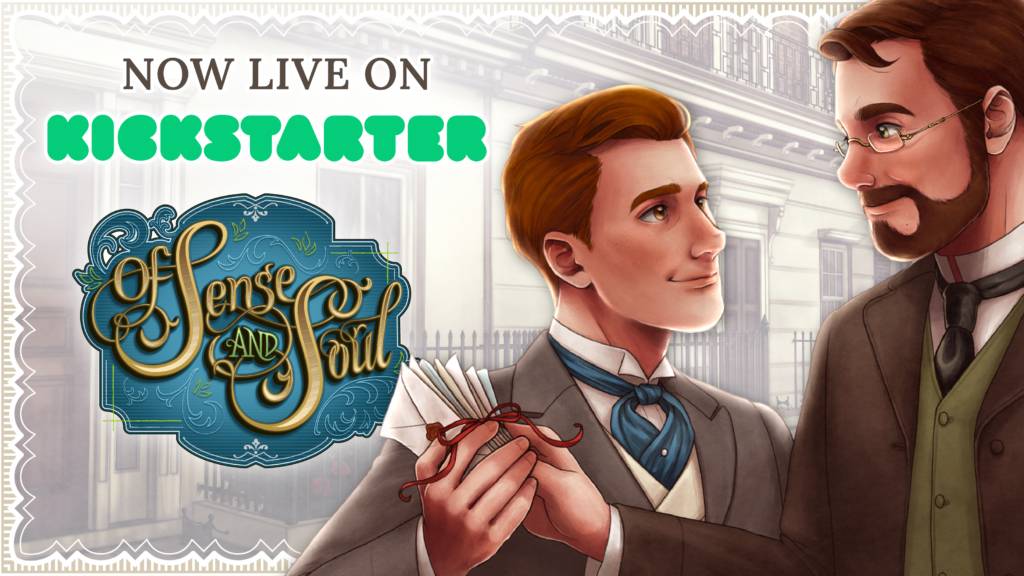
The responses to our Kickstarter Interest Survey as well as player demographics shown on Steam told us that a majority of our audience was based in North America, and so the campaign was timed to start during the evening for the EST and PST time zones.
Heeding the advice from this GDC talk, we also scheduled the launch for a weekday in order to capitalise on people’s availabilities during the week.
And so, on Thursday, July 13th at 8AM UTC+8, the campaign for Of Sense and Soul began! It lasted for 30 days until Saturday, August 12th at 8AM UTC+8.
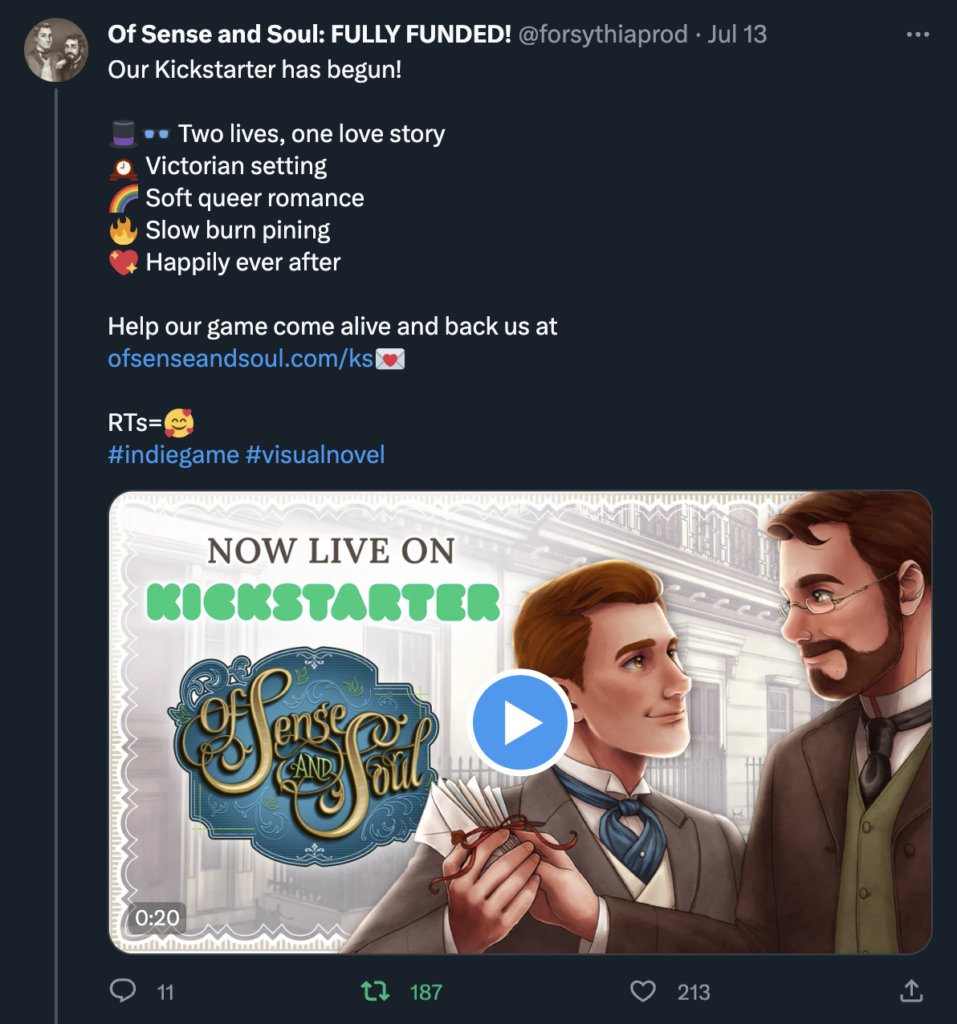
The Start
The start of our campaign was a wonderful motivator—we were able to raise 30% of our goal in the first 24 hours!
At 48 hours, we had reached 33% of our goal. This was, we thought, a great indicator that we could comfortably fund the game in the remaining 29 days.
(Prior to launching, we also had 228 Pre-Launch followers.)
To accompany the launch, I had arranged for one promotional stream each from Psyche and JeffBrutlag.
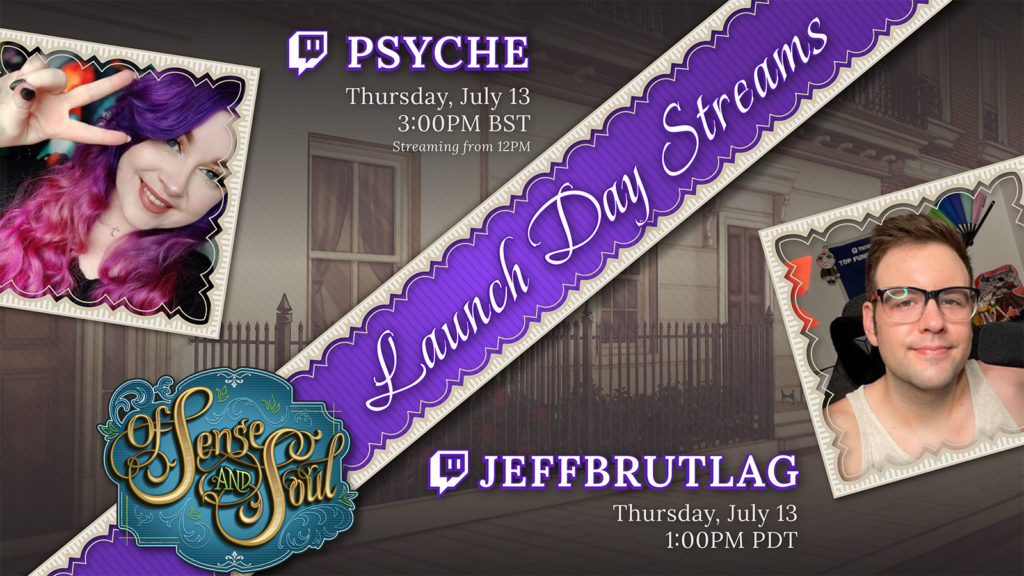
The streams were a lovely reassurance about the quality of the game itself, and it was very clear that OSAS has a strong story and presentation. I thought we were looking in the right places, as far as seeking our audience goes.
Although I was unable to connect any backings from the referral link from Psyche’s campaign to direct pledges, there were three from Jeff’s stream which did register. Some of his chat members also posted about the game on their own Twitter profiles, which was a nice surprise!
It was just at the end of his stream, at the end of the first 24 hours, that we hit 30%. Then, the campaign began to slow down.
The Limbo
Things became eerily quiet after those first 48 hours.
It’s natural for there to be a lull after the initial excitement of any campaign, so to distract myself and keep spirits up, I continued developing Seamus Chapter 1 in preparation for our 50% funding milestone reward.
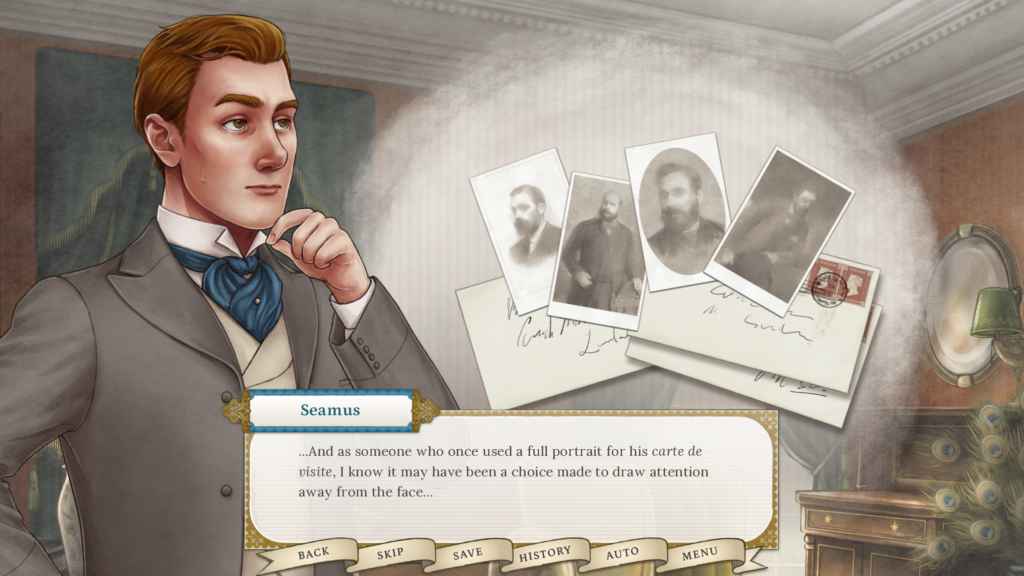
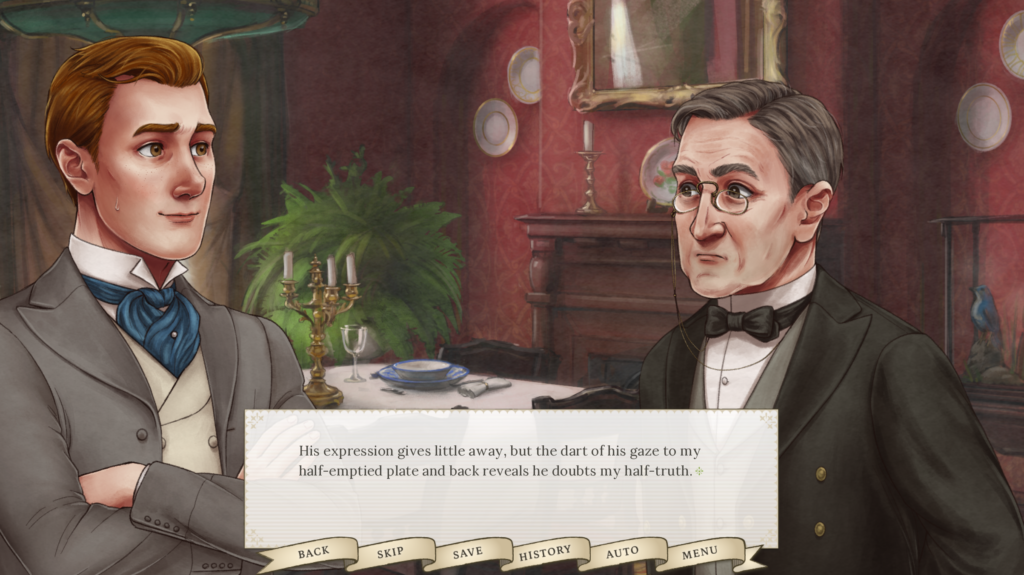
The Milestone Rewards were announced in the hopes of speeding up our campaign, to giving us a better chance at funding fully and overfunding into our stretch goals.
Despite consistent posting and pushing of those additional incentives, it was a struggle to reach even the 40% mark. It took several days to raise an additional 2% on our goal at around the halfway point of the campaign.
Interviews
During this time the public posts for a few interviews I had been invited for also went up, including the following:
- Scene Direction in Of Sense and Soul
Developer Interview with Arimia (who also has many amazing posts on VN dev and marketing on her blog) - Of Sense and Soul, a Queer Victorian Romance Interview
Questionnaire with All Ages of Geek - Interview with ingthing
Live chat on making Of Sense and Soul with SailingOcelot on Twitch.tv
These interviews were a great opportunity to talk about the game and get more granular about the project after being so entrenched in the promotions side of it for the duration of the Kickstarter.
Makes the Dream Work
Through this middling period, the support I received from my team cannot be overstated—everyone was doing their utmost to support the campaign both behind the scenes and on our socials, and even helped ideate for new post content in our development server.
This reinforced the reason why I had started the campaign in the first place: if OSAS’ campaign succeeded, I would immediately be able to support my team in a more consistent manner—not only in support of their crafts, but also in the belief that our work on the game is meaningful! I was determined to see the campaign to the end and beyond.

The End
With just eight days to go we had still only grazed 48%—not even half of our funding goal.
At the start of that final week, I had already begun preparing back-up plans and checking in on the rest of the team to ensure they knew what would happen if the campaign failed.
We knew it would be down to those final 48 hours to get to our goal, and by the time those 48 hours began, we had managed to work our way up to 65% of it. The campaign itself had 546 followers by this point, and we hoped a decent chunk of them would come to the campaign’s aid in that time.
With just over 12 hours remaining, we were at 72% funded. I had already fully prepared two sets of promotion materials: one for success, and one for the alternative. At that point, I never expected the former to see the light of day.
Miraculously, we reached our goal. With one pledge, it all changed.
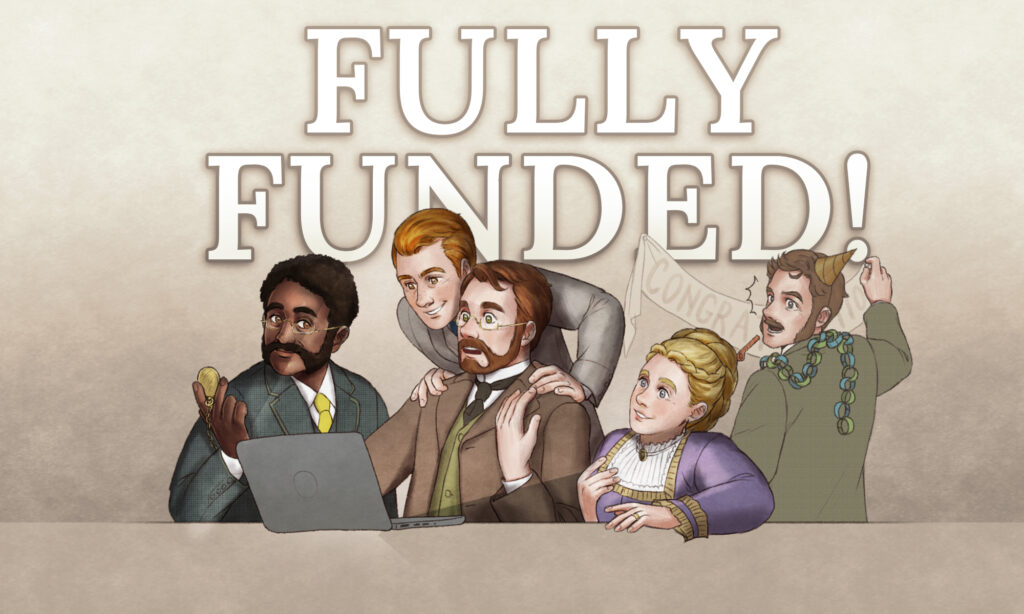
Half-awake, I double checked to see the pledge was real, then hastily revised and made my posts. Once all the relevant announcements had been put up and the campaign had ended, I then napped for the rest of the day; the news only really sank in that night.
(It’s still sinking in as I write this, several days later!)
Results & Reflections
Now that the dust has settled and there’s been some time to breathe as we wait on Kickstarter to transfer the funds to our end, there has been time to reflect, as well. But first, some statistics:
Results (The Numbers)

At the end of the campaign we had, by the skin of our teeth, raised 103% of our goal for a total of HK$161,454 (about US$20,650). As I prefaced, it was only in the last 40 minutes of the campaign that our fortunes completely changed!
We also just made it to the first stretch goal of an in-game bibliography which was announced within those last 40 minutes.
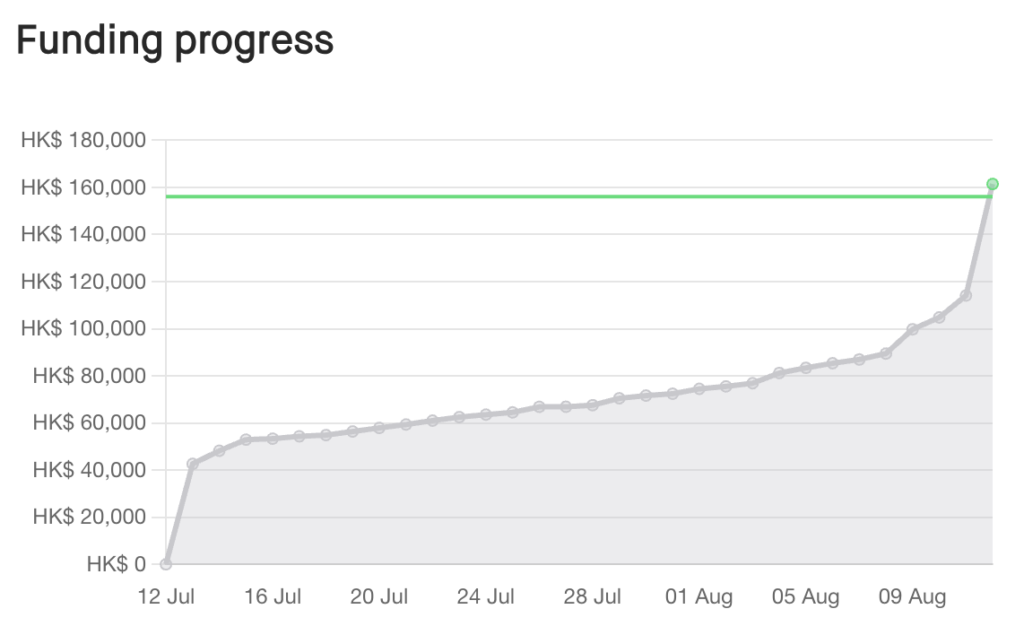
- Number of Backers: 291
- Average Pledge (Trimmed): HK$390
- Most Popular Tier: Reflection (Game Tier) with 110 backers
Our average pledge wound up being quite high at HK$390 or about US$50 out of 290 backers (trimmed to exclude the outlier pledge which accounted for 30% of our goal.) The most popular tier was the Reflection Tier which included the game itself, as we expected!
As for our Community Challenges, we came close to unlocking two, but ultimately reached just the Love Letters challenge.
- Spread the Word ☐ An animated voice blooper reel reward
- Needed: 300 Tumblr Notes, 200 Retweets, 200 Backers
- Final: 804 Tumblr Notes, 187 Retweets, 291 Backers
- Love Letters ☑︎ A short OSAS story added to all tiers (Unlocked!)
- Needed: 20 Posts across Twitter, IG, and Tumblr
- Final: 20+ Posts
- Inspired Work ☐ Bonus art, to be voted on by backers.
- Needed: 20 Posts across Twitter, IG, and Tumblr
- Final: 13 Posts
On our broader presence over the course of those 30 days, our newsletter gained 25 subscribers, our Twitter gained ~70 followers, and our Tumblr gained 39 followers.
Our Itch.io page for OSAS saw 58 referrals from Kickstarter itself. We gained around 154 wishlists on Steam, with around 75 of those coming in after the start of Steam’s Visual Novel Fest.
Reflections
It’s surreal to think I now exist in a Post-OSAS-Kickstarter world!
If there’s one thing I’ve learned from this campaign, it would be this:
You can try and do everything right for your campaign, your project, and your people, to the very best of your ability—but you will always bear the weight of many other external factors; factors that, more often than not, are out of your control.
As confident as I was in the game’s presentation and inherent quality, we still fell very close to the campaign failing. Though I am happy I set our goal for the ~US$20,000 we did, as it encompasses fair compensation not only for our team but also for Rowan and myself, it would certainly have been easier to fund in full if we had had a reduced goal.
One factor we certainly had no control over was the economic state of the world, or the individual financial circumstances of prospective backers down to the day. (Kickstarters are built to encourage donations of lump sums of cash, when it is sometimes more viable for supporters to divide that into monthly contributions.)
On Marketing
Once our campaign began, there wasn’t too much I could do to give it a boost during its run—it is incredibly true that you have to bring your audience to Kickstarter rather than expecting to find it there. It’s our fans who pulled us through to the success of the campaign, and fans are extremely hard to convert without an established connection to your game. The work I had done on the demo, on Confluence, and on our marketing prior to the campaign really helped bring fans in for it, which I believe contributed to our strong start.
I would even go so far as to say it’s more important to market hard and consistently before your campaign than it is to show up during it.
Though it’s important to be consistent during those 30 days, I was only able to make that posting happen after having trained myself into the mindset required for that kind of marketing during the months prior.
It’s especially difficult as a solo developer to switch from making something to promoting it, and posting frequently was necessary to desensitise myself to it enough for the campaign’s posts to feel lower stakes. I was simply posting the way I had always been, at that point, albeit with more persistence!
On Campaign Length/Struggles
Given the option of setting my campaign for 30 days, 60 days, 90 days, or even less than 30, I think I would still have chosen a month-long one. Any shorter for a goal of our circumstances, and you’d risk missing potential backers who haven’t received pay-checks or been too occupied for that short time. Any longer, and there would be far more content and marketing to manage—which brings me to the waiting.
One thing that took me by surprise, besides the surprise of last minute full funding, was simply how difficult it was to wait. Being the lead developer of the game and sole manager of the campaign, there were thankfully tasks such as writing updates, adding to the game, and keeping track of social media to take my attention away from the campaign. It didn’t feel good to have something I put my heart and all my abilities into enter a sluggish crawl to the finish line, or to see it almost fall very short of it.
I held onto hope until the end, but that slow “death” of the campaign, knowing how many other people were holding their breaths along with me as they refreshed the campaign page, was incredibly difficult.
It was all I could do to focus on delivering updates consistently and put my best foot forward with poise.
It did, however, make the collective sigh of disbelieving relief at the end of the campaign all that much better!
Conclusion
As a fellow VN developer friend of mine said to me in the last days of the campaign, very few human beings have ever been or will ever be in the position I was in as the countdown to the end of the campaign steadily ticked onward.
I had already decided that by that point, I was proud of myself and my team, and that wouldn’t change whether we reached full funding or not. I had weighed the outcomes, and knew that I’d be making Of Sense and Soul happen no matter what—and was in fact fully prepared for if funding fell through. I would have found other sources or tried again, perhaps with a lower goal, at some future time, as so many devs do.
What I took away most from this effort was the immense support and love from everyone who has come across our game or crossed paths with me in dev spaces.
In an otherwise isolating pursuit of indie visual novel development, it was revitalising to be as seen as we were by this community and by our players for the campaign’s 30 days as well as the build-up to them.
I hope this tale and these thoughts I’ve shared prove useful for many of you, and that it at least was an interesting (though time-consuming) read!
This is only the start of the rest of the creation of Of Sense and Soul—no doubt there will be future struggles to come, but I am thankful this campaign has prepared us well with both the resources and the courage to face whatever does.
End
If you enjoyed this post-mortem, consider clicking the links below to keep up with the rest of the game and my work!
